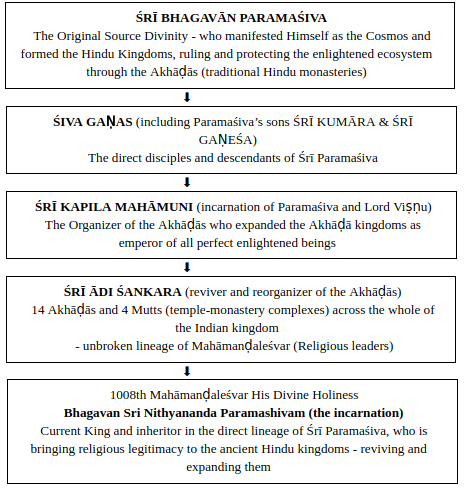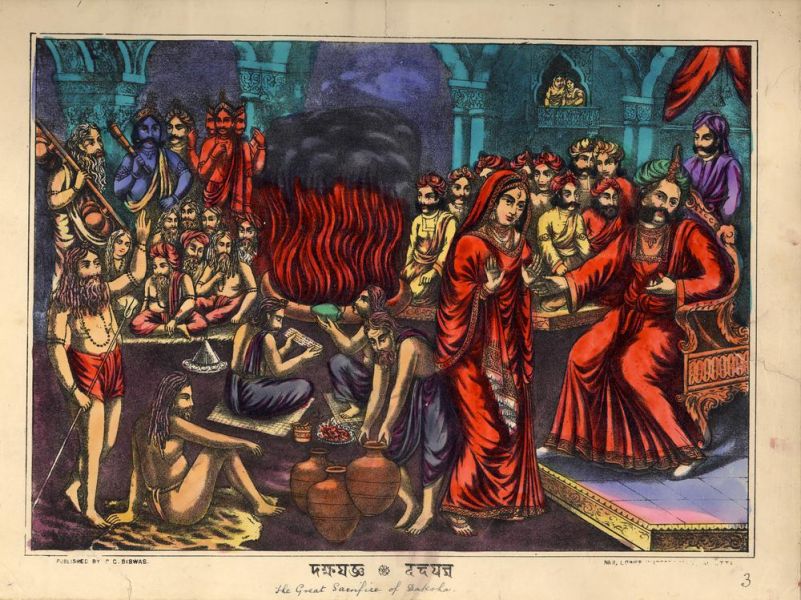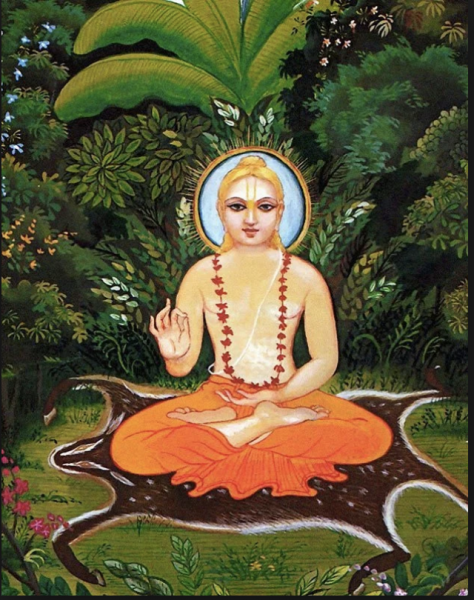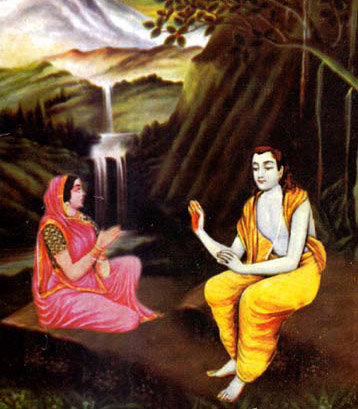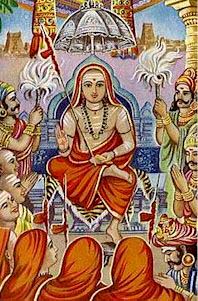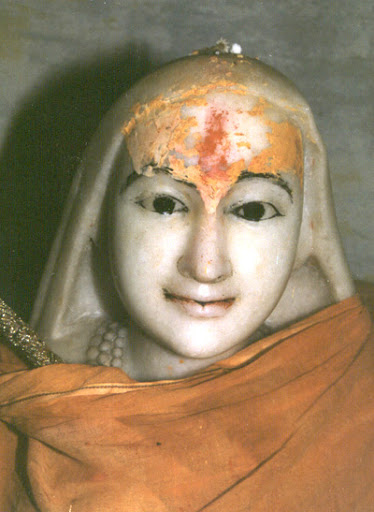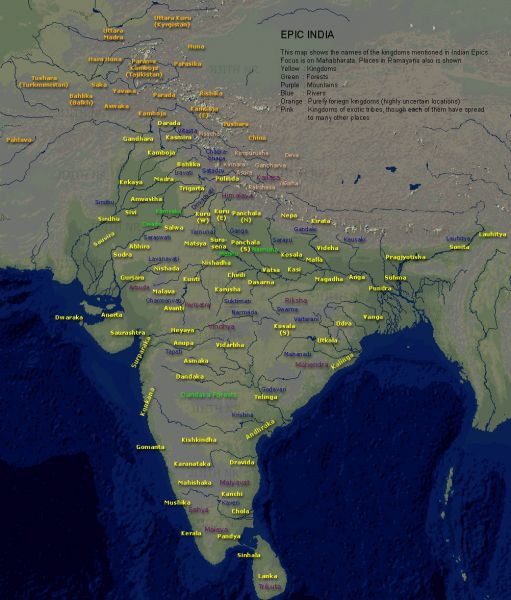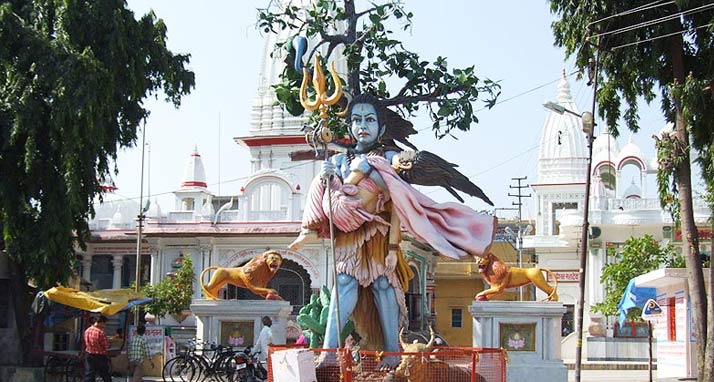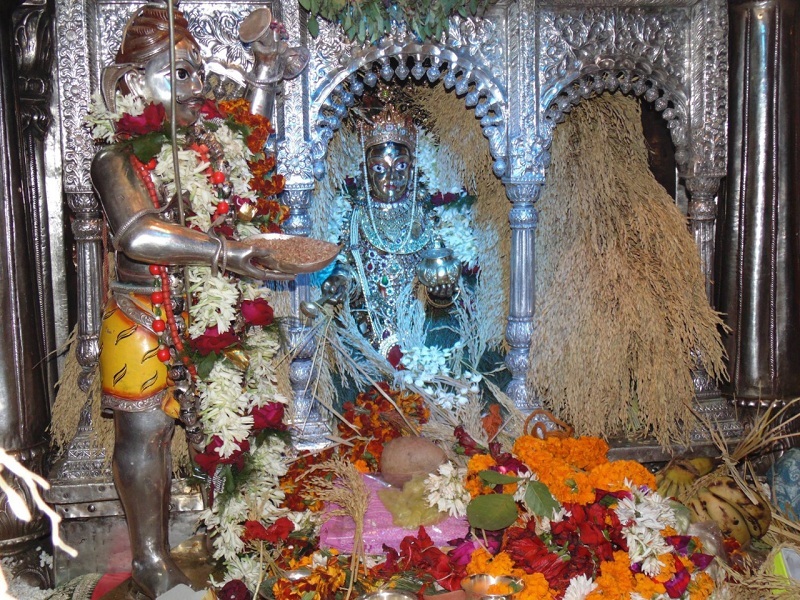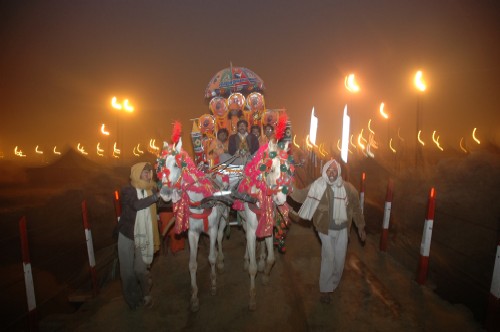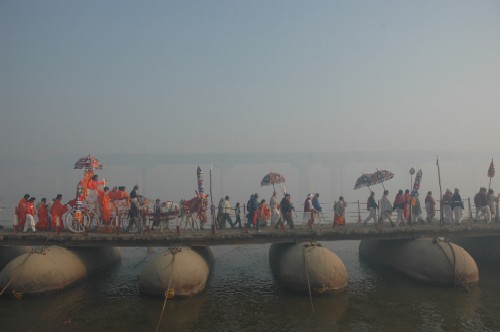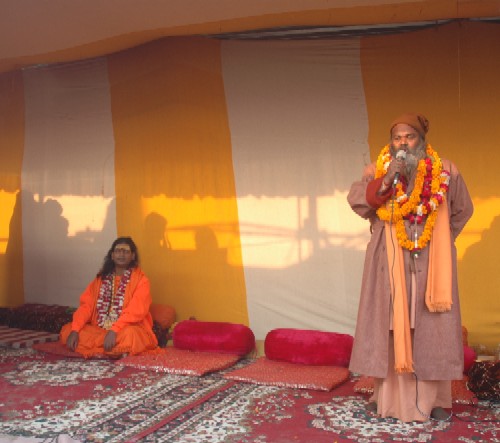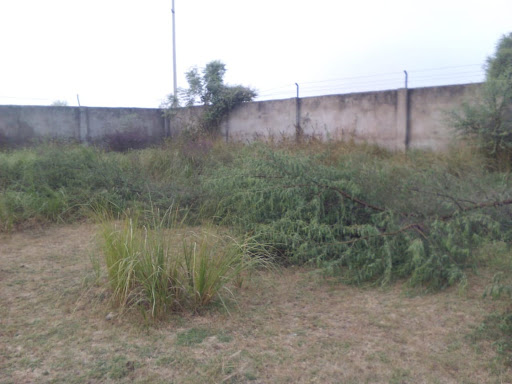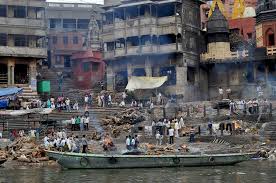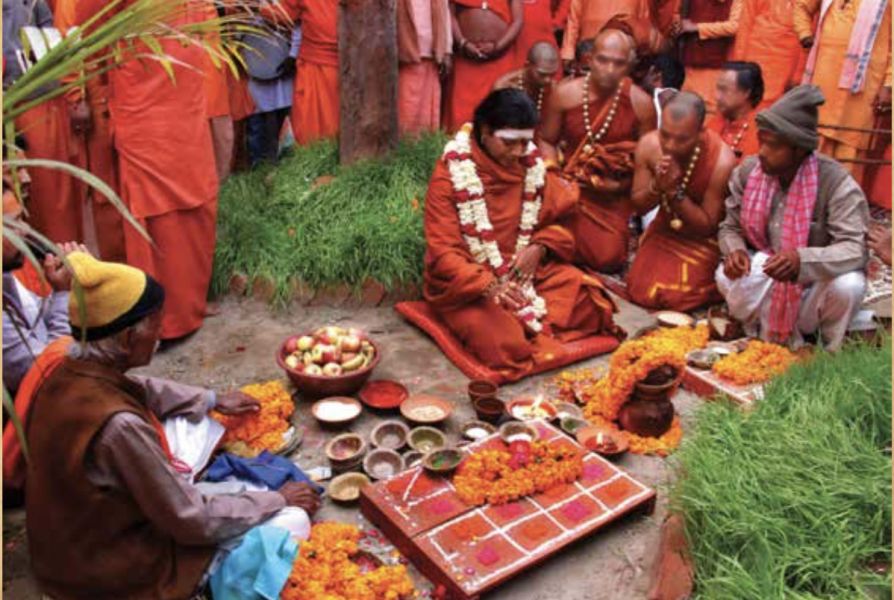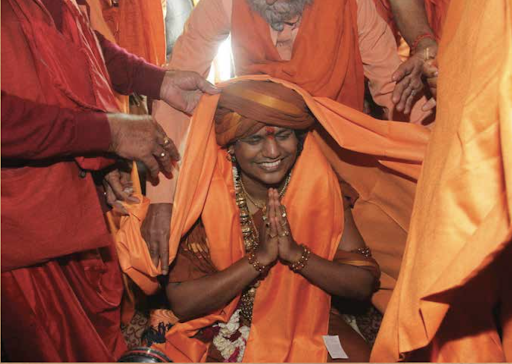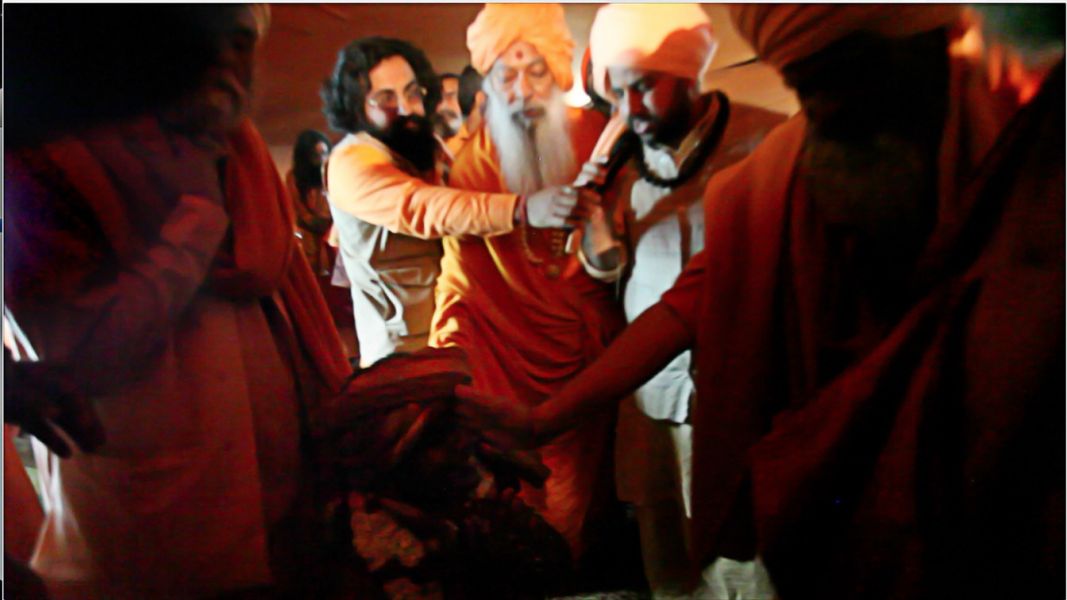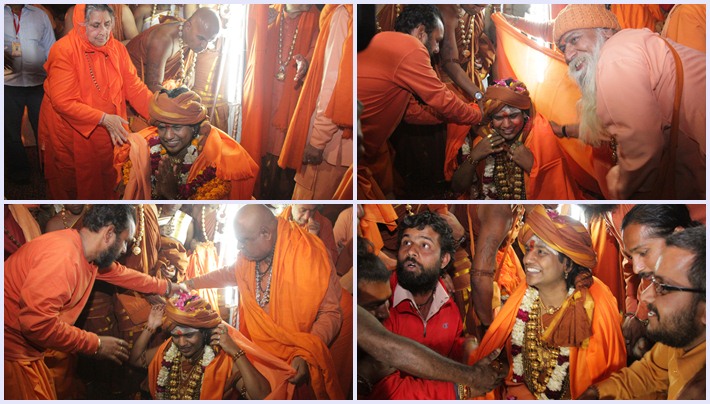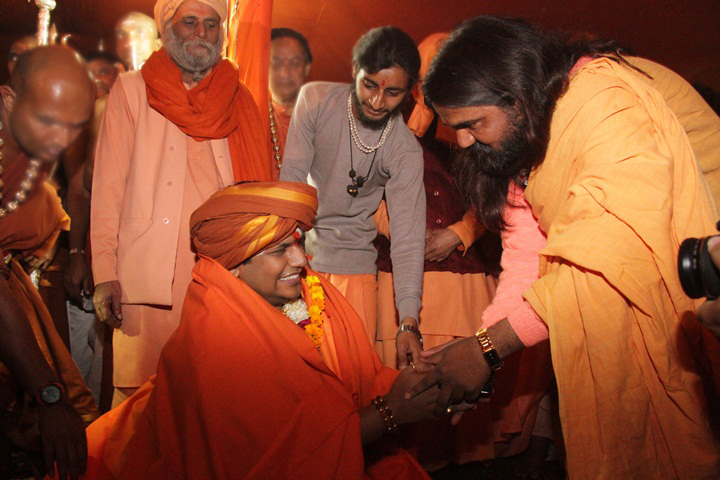Kailaasa Paramparagatha Mahanirvani Peetham
Paramaśiva, the Cosmic Source and ultimate Divinity, started the lineage of Akhāḍās with the ascetic warriors (Nāgā Sādhus) along with His direct disciples and descendants - called the Paramaśiva Ganas. ( https://www.wisdomlib.org/definition/paramashiva;)
The Daiva Paramparā (Divine Lineage)
Bhagavan Sri Paramaśiva
It is from Bhagavan Sri Paramaśiva, the Primordial Source, came forth the most ancient living lineage of ĀdiŚaiva traditions and sanyas (monkhood) called ‘Akhāḍās’ of ascetic warriors who defend the land and Dharma (the Cosmic law). Paramaśiva came down to the sacred city of Varanasi in North India with his empowered direct disciples (Śiva ganas) and sons Śrī Kumara and Śrī Gaṇeśa (king of Gaṇas, followers of Paramaśiva) and established the eternal unbroken spiritual flow of ascetics, forming the first Akhāḍā.
The Original Akhāḍā Structure
Daksha (Son of Lord Brahma) was called Daksha Prajapati as he functioned as the President of humanity during his times. He delivered the Daksha Smṛti - The Do's and Dont's - for Humanity. He organised a massive Yaga (sacrificial fire) for which he deliberately avoided calling his daughter Sati and Her Divine Consort Paramaśiva Himself. When Sati, pulled by parental bonding, went by herself to the Yaga, Daksha further insulted her in front of the entire gathering. Sati unable to withstand the insult of her own father, self-immolated herself in the sacrificial fire. News reached Paramaśiva, who invoked Vīrabhadra to slay Daksha's head. (Ref:https://www.britishmuseum.org/research/collection_online/collection_object_details/collection_image_gallery.aspx?assetId=790923001&objectId=3267281&partId=1)
Daksha fell low in the eyes of all after this incident. The Sapta Rishis refused to henceforth follow Daksha Smṛti as they saw that Daksha was no more integrated to Paramaśiva, (Primordial Hindu Divinity). They requested Paramaśiva to reveal the guidelines yet again to them so they can follow. The sacred spot where Paramaśiva revealed the Agamas to them, is the Daksheshwar temple of Mayapur in Haridwar, where the Kailaasa Paramparagatha Mahanirvani Peetham (spiritual and religious kingdom) is headquartered. Even from during the times of Daksha, this temple was the headquarters of the Peetha.
After revealing the Agamas, Paramaśiva appointed Sage Kapila as the Head of the Mahanirvani Peetha, thus establishing the Mahanirvani Peetha.
Thus, Bhagavān Sri Paramaśiva, the ultimate Divinity, institutionalized the constitution, administration and protection for this enlightened ecosystem on the planet by establishing the ‘Akhāḍās’ (traditions within Hinduism) with His direct disciples and descendants called the Paramaśiva Gaṇas and warrior ascetics (Nāgās) from Varanasi, the most ancient living city of earth. Under His divine ordainment, the spiritual, religious, historical, political, economic and social ecosystems were formally established. (Ref.: https://en.wikipedia.org/wiki/Akhara).
One of the main responsibilities of the Akhāḍās is teaching and transmitting the great teachings of Shāstras (revealed scriptures from Paramaśiva). Thus the ascetic monks (Nāgās) are called Shāstradharis (Shāstra - the scriptures; dharis - bearers) in Sanskrit. They also use Śastra (weapons) to protect the sacred traditions from external negative forces. Wielding of both Śāstra and Śastra - knowledge of scriptures and weapon - within the scope of the Dharma (Cosmic Law) is the main responsibility of the Akhāḍās.
Lord Śrī Kapila Mahāmuni, the organizer of Akhāḍās - glory and lineage
Incarnation of Paramaśiva and Lord Viṣṇu, from the Sūrya vaṁśa, the Sun dynasty
Lord Śri Kapila Mahāmuni is the incarnation of Lord Śrī Paramaśiva and Lord Viṣṇu, who appeared in the Sūrya vaṁśa, the sun-dynasty as the son of glorious Prajāpati Kardama, one of the nine sons of Lord Brahma and procreator of human life on planet earth and as the son of Devāhuti, the daughter of the reigning Manu Svayambhuva (the lord of the first manvantara or aeon) the original ancestor of the Sūrya vaṃśa, the Sun Dynasty.
Srimad Bhagavat Purāṇa, the Hindu scripture (purāṇas are scriptures that record the historical happenings of cosmos, of cosmic laws (dharma), of all incarnations) gives detailed accounts about Śrī Kapila’s divine lineage and His purpose:
Anasūyā is the Mother of Bhagavan Dattatreya, the Incarnation (establishing Dattatreya in the lineage of Manu)
अत्रेः पत्न्यनसूया त्रीञ्जज्ञे सुयशसः सुतान्
दत्तं दुर्वाससं सोममात्मेशब्रह्मसम्भवान् ॥ ४.१.१५ ॥
atreḥ patny anasūyā trīñ jajñe suyaśasaḥ sutān
dattaṁ durvāsasaṁ somam ātmeśa-brahma-sambhavān
- Śrimad Bhāgavatam 4.1.15
Translation: Anasūyā, the wife of Atri Muni, gave birth to three very famous sons — Soma, Dattātreya and Durvāsā — who were partial representations of Lord Viṣṇu, Lord Śiva and Lord Brahmā. Soma was a partial representation of Lord Brahmā, Dattātreya was a partial representation of Lord Viṣṇu, and Durvāsā was a partial representation of Lord Śiva.
Devāhuti, the daughter of the Sūrya Vaṃsa (Solar dynasty’s), is mother of Lord Kapila. Lord Kapila Mahāmuni is the Siddhagaṇadhīśa, the emperor of perfected beings (establishing Kapila in the lineage of Manu)
एष मानवि ते गर्भं प्रविष्टः कैटभार्दनः
अविद्यासंशयग्रन्थिं छित्त्वा गां विचरिष्यति ॥ ३.२४.१८ ॥
eṣa mānavi te garbhaṁ praviṣṭaḥ kaiṭabhārdanaḥ
avidyā-saṁśaya-granthiṁ chittvā gāṁ vicariṣyati
अयं सिद्धगणाधीशः साङ्ख्याचार्यैः सुसम्मतः
लोके कपिल इत्याख्यां गन्ता ते कीर्तिवर्धनः ॥ ३.२४.१९ ॥
ayaṁ siddha-gaṇādhīśaḥ sāṅkhyācāryaiḥ susammataḥ
loke kapila ity ākhyāṁ gantā te kīrti-vardhanaḥ
- Śrimad Bhāgavatam 3.24.18-19
Translation: L ord Brahmā then told Devahūti: My dear daughter of Manu, the same Absolute Lord who killed the demon Kaiṭabha is now within your womb. He will cut off all the knots of your ignorance and doubt. Then He will travel all over the world.
“Your son will be the emperor of all the perfected being, Siddhagaṇadhīśa. He will be approved by the Acāryas, the spiritual authorities, experts in transmitting the real absolute knowledge, and among the people He will be gloriously celebrated by the name Kapila. As the son of Devahūti, He will increase your fame.”
About 20,000 years back, Śrī Kapila Mahāmuni brought forth the “Science of pure thought currents to humanity called Sānkhya Darśana’’ initiating a revealing this science first to his mother Devahuti. Sānkhya is the naked philosophy of the Truth. Śrī Kapila Mahāmuni lived in Varanasi, who further formed and organized the Akhāḍās, which became the foundation for all other Akhāḍās. Many of the shāstradhāris (the ascetic warriors bearing revealed scriptures) of the Akhāḍās, carried their bodies with spiritual purity and freedom. (Ref.: https://en.wikipedia.org/wiki/Kapila)
Thus was born the naked Nāgā Sādhus of the Mahānirvaṇi Akhāḍā. Śrī Kapila also created the Dasanāmi Sampradāya – the tradition of 10 Sanyāsa names given to various Sanyāsis of the Akhāḍā. द॒शा॒नामेकं॑ कपि॒लं (daśonāmekam kapilam) – meaning among 10 divine names is “Kapila” – says Rig Veda 10/27. (Rig Veda is one of the four main Vedas, the revealed source scriptures in Hinduism) (Ref.: https://en.wikipedia.org/wiki/Mahanirvani_Akhara)
Śrī Kapila Mahāmuni is also known as ‘Sākhya Muni’ or ‘Sānkhya Muni’. The Buddha, in the lineage of Mahānirvani Akhāḍā also came to be known as the ‘Sākhya Muni’ .
His Divine Holiness at the Śrī Nithyanandeshwara Paramaśiva Devasthānam (the main temple at the Dhyanapeetha Matha , monastery at Bengaluru), with the living deity of Śrī Kapila Mahāmuni (extreme right) consecrated in the main sanctum.
Śrī Ādi Śankarācārya - The Reviver and Organizer of the Akhāḍās
Sri Ādi Śankarācārya is an incarnation of Paramaśiva, who descended in the 8th century. He organised and unified the main thought currents (Truth threads) that exist within Sanātana Hindu Dharma, in the form of various traditions or Sampradāyas called Akhāḍās. He is the organizer and reviver of the Dashanami Sampradāya (the monastic tradition), organizing a section of the Ēkadaṇḍi monastics under an umbrella grouping of ten names (‘daśa’ meaning ten, ‘nām’ meaning name in Sanskrit). He also revived and organized the Mahanirvani Akhāḍā. He formally organized it in 748 C.E constituting a democratic structure giving stability and legitimacy to Hinduism’s core spiritual traditions (sampradāya) in the form of the Akhāḍās or Apex bodies of Hinduism. (Ref.: https://en.wikipedia.org/wiki/Adi_Shankara )
The Ekadandi Sanyāsis (wandering renunciates and monks bearing a single staff) were organised into ten sects or names (daśanāma), which fell under four Mathas or monasteries under the sacred system entirely based on the guru-disciple tradition, where the lineage of each sect was maintained and inherited from Guru to disciple. (Ref.:https://en.wikipedia.org/wiki/Dashanami_Sampradaya#%C4%92kada%E1%B9%87%E1%B8%8Dis)
All the knowledge and traditions of Sanātana Hindu Dharma (Hinduism) are traced back to the original source, which is Paramaśiva. The Guru-parampara (Guru’s lineage) begins with Paramaśiva as the primordial Guru, who descends as the Incarnation from time to time to transmit, preserve and protect the Science of Enlightenment and the enlightenment ecosystem to for his disciples and humanity at large. This is the Daiva-Paramparā, which is followed by the Rishi-Parampara, where the enlightened seers were able to transmit the direct words of Paramaśiva to the next generation of seekers. Finally, comes the Mānava-Paramparā, where the disciples who received this knowledge maintain and uphold the tradition from one generation to the next.
Background of the Mahanirvani Akhada
Akhāḍās form the core body of the Hindu tradition, they are the oldest and largest Apex body of Hinduism. As of now at least 1 million Sādhus (saints) are dedicated and live under the Akhada Parishad, which is the apex council body of Hinduism with a democratic selection structure of its spiritual leaders, where all the fourteen Akhadas are members.
14 Akhāḍās are accepted widely, as main stream Akhāḍās, but there are many minor Akhāḍās affiliated to these, which function as the sister organizations or subsidiaries, carrying ideological connection yet having their independent identity.
Varanasi or Kashi was the spiritual headquarters of Kailaasa Paramparagatha Mahanirvani Peetham where Sri Kapila Mahāmuni’s Māhā Jīvasamādhi (final enlightened resting place) is located. Haridwar is the current spiritual headquarters
Sectarian Structure of the Sadhus (ORTHODOX SHAIVA SAMPRADAYAS - Shaiva Traditions)
Dashnami Sampradaya
Dashnami Sanyasis are broadly divided into two sections namely, Astra Dharis (weapon-holders) and Shaastra dharis ( scripture holders). Astra Dharis are ascetic warriors and Shaastra dharis a re learned ascetics.
Shankaracharya, the reviver saint of the Dashnami Order, realised that unless there is a warrior class of ascetics who fiercely protect it, the Order re-established by him cannot last long. Similarly, Hinduism had undergone extreme persecution where its scriptures, palm leaf manuscripts, books and such sources of knowledge were stolen, burnt, destroyed and maliciously misinterpreted. There was now a need for the Sanyasis of the country to physically protect against invasions, as well as protect the knowledge and ancient heritage of Hinduism itself. So, he recruited warrior and scholarly Sanyasis to form the ten orders of Sanyasis who came to be known as Dashnami Sanyasis.
Dashnami Naga Sanyasis in particular were imparted military training, as well as expected to be highly knowledgeable in the Hindu scriptures.
A short account of the original Dashnami Akharas is given below:
1. Awahan Akhara: It was revived in 546 A.D. The tutelary deity is Gajanan Dattatreya. The head office of this Akhara is situated at Kashi (Varanasi) and branches are at Haridwar and Prayagraj.
2. Atal Akhara: It was revived in 646 A.D. in Gondwana with Ganesh (Paramasiva’s own son) 30 as its tutelary deity. This Akhara has its branches in Haridwar, Ujjain and Baroda, and its head office at Kashi (Varanasi).
3. Mahanirvani Akhara: It was founded at Jharkand (Vaidyanath Dham) in 748 A.D. with Kapil Muni as its tutelary deity. This Akhara has its head office at Haridwar and branches at Kankhal, Kashi, Nasik and Ujjain.
4. Anand Akhara: This Akhara was revived in 855 A.D. with Surya Deva (Sun God) as its tutelary deity. The Atal, Anand and Awahan Akharas are affiliated to Nirvani, Juna and Niranjani Akharas respectively.
5. Niranjani Akhara: It was revived at Kachcha Mandavi in 903 AD. with its head-office at Prayag and branches at Ujjain and Udaipur. The tutelary deity of this Akhara is Kartikeya (or Subramanya - Parasiva’s own son). It is the protective army of Kartikeya that turned into the Niranjani Akhara of Sadhus.
6. Juna or Bhairo: It was revived in 1145 A.D. at Kama Prayag with Rudravatar Dattatreya as its special deity. Main centres of this Akhara are situated at Kashi, Prayag, Hardwar and Ujjain.
7. Nirvani Akhara: Nirvani and Niranjani akhada are considered as the leading akhadas from the point of view of the number of members and movable property.Only advanced aspirants are initiated into these Akharas who have already received preliminary instructions from the Guru.
Shankaracharya also organized the Dashnami order, which includes the following ten categories of Sanyasis. (1) Giri (hill) meaning living in the hills (2) Puri (City) meaning living in the city (3) Bharati (goddess of learning) meaning to be established in learning (4) Vana (Wood) meaning living in the woods (5) Parvata (Mountain) meaning living in the mountains (6) Aranya (forest) meaning living in the forest (7) Sagara (ocean) meaning living by the ocean (8) Tirtha (Pilgrimage) meaning travelling, visiting holy shrines and enriching people (9) Ashrama (hermitage) meaning living in a hermitage (10) Saraswati (symbol of knowledge) meaning being blessed by Goddess Saraswati and therefore well established in the ocean of knowledge.
Shankaracharya also established four big monastic centres namely Jyotir Math. Shringeri Math, Govardhan Math and Dwaraka or Sharda Math in North, South, East and West respectively and installed his disciples there to propagate his religious message to the world.
The four great Mathas of the Dashnami order, have in the course of centuries come to adopt certain definite rules of affiliation and organisation. A Sanyasi must first of all enrol himself in a Marhi (recruiting centre). A Math can take members belonging to one Marhi only but all the fifty-two Marhis can become the members of Akharas.
Picture: Dandi Sanyasi, a Hindu ascetic, in Eastern Bengal in the 1860s
The Dashnami Sanyasis are further divided into two broad sections namely Dandadharis (staff holders) and Paramahamsas (not holding a staff). Out of the ten sub-sects of the Dashnami Order, Sanyasis of only three sub-sects that is, Tirtha, Ashram and Saraswati, hold a staff and the rest called Paramahamsas do not hold a staff. The three Dandi sub-sects initiate only Brahmanas as ascetic disciples but in the rest, persons from Kshatriya (warrior caste) and Vaisya (merchant community) Varnas (castes) may also be initiated.
In Varanasi, the home of Shaiva ascetics, twenty-eight Mathas (monastic centres) are managed by Dandis and fifteen are managed by Paramahamsas.
Dashnami ascetics are graded according to their spiritual attainment into four categories as follows:
1. Kutichaka: He is an ascetic who has renounced the world and lives in a hut engaged in contemplation and worship. He subsists on alms given to him by others.
2. Bahudaka: Such ascetics collect alms in kind but never in cash.
3. Hansa: Such ascetics are well-versed in Vedanta (Scriptural knowledge) and pursue the aim of attaining complete knowledge of the Supreme Being.
4. Paramahamsa: Such ascetics represent the stage of highest spiritual evolution.
Kumbh Mela
Along with the Mahanirvani Akhāḍā, Kapila created the tradition of the Kumbh Mela – till date the world’s largest gathering of humanity and the ultimate celebration of freedom from all bondages of the world. The Kumbh Mela happens even up to 55 days and provides an extremely high energy enlightenment ecosystem where clairvoyance happens and one’s peak possibilities for enlightenment are awakened through various means.
Puranic History of the Kumbh Mela festival - the largest gathering of humanity in the world
Following are extracts from the narration of the story of “the Churning of the Milky Ocean” by His Divine Holiness Bhagavan Nithyananda Paramashivam on 4 Aug 2007:
“It was Narada (Hindu Sage) who started everything. One day, he saw the jewel on the chest of Vishnu, a new jewel - the Shamantaka, a beautifully shining jewel on Vishnu’s chest. And he asked, “Bhagavan, from where did you get that? He said, “Some devotee gave. Varuna raja, King of the Ocean.” Narada thought, “Oh god! Such a pretty jewel.” He went and spoke to Indra (chief of Gods). He told Indra, “Indra, look! Varuna is your servant but he took the Shamantaka and gave it to Vishnu; he did not give it to you.” Indra got very annoyed but he can’t show that directly to Narada because he knows Narada will go and tell Vishnu. So he said, “No, no, no! He gave it to Bhagavan (a term used to refer devotionally to God) , it’s ok, leave it. It should be with Bhagavan.” But immediately he called Kubera (Lord of wealth) and said, “How dare Varuna will hand this over to Vishnu without asking us?” This was because, all the Nidhi (wealth) of the Planet Earth and the Ocean, belong to Kubera. Conch is the wealth of the Ocean. All the things and jewels of the ocean are denoted by the Shankha, conch. All wealth that comes from the land is denoted by the Padma - the lotus. So, both belong to Kubera.
Now Kubera calls Varuna and straight away asks, “How come this did not come to my treasury?” Varuna says, “You are Yaksha, He is Lakshmi.” Yaksha means the one who possesses wealth but neither enjoys it nor lets others enjoy it. Lakshmi means the one who keeps the currency moving; who enjoys and lets others enjoy. So Yaksha gives importance only to hold wealth; Lakshmi means “rotating currency”. Varuna says, “Even if I give it to you, it will only be sitting inside a treasury. No one will ever know, nobody will see it. Don’t you see how pretty it looks on the chest of Vishnu? That is why I offered it at the feet of Vishnu. He is wearing, He is enjoying.”
Kubera makes a petition to Indra saying, “This cannot be accepted. Now we don’t know what all wealth Varuna is hiding, so let us churn (the ocean) and bring everything out. Let us bring the whole thing to the treasury now itself. Nothing should be left with the Varuna Raja.” This is where the problem started. Now, both Indra and Kubera decide to churn Varuna Raja, the ocean and get all the wealth out and put it in Kubera’s treasury; they decided that it should not be left with Varuna anymore. They decided that they will not inform or invite the Trimurtis (Trinity of Paramasiva, Brahma, Vishnu) because the whole plan is against Vishnu!
Varuna falls at the feet of Vishnu saying, “Bhagavan, I don’t know what happened and what they are trying to do. They decided to form a friendship with the Asuras (demons).” Then, Vishnu smiles and says, “Forget it, they will come to me because they have bought trouble. Where else will they run? I will take care.”
Then, the Asuras and Devatas, demons and divine beings decide that the Meru mountain should be the spindle for churning. Meru is the sacred five-peaked mountain of Hindu, Jain and Buddhist Cosmology and is considered to be the center of all the physical, metaphysical and spiritual universes. Vasuki, the snake on which Vishnu is resting, was used as the rope.
The rope is Vishnu’s, the Spindle is Paramashiva’s! Now, they discuss what to do, and how to get both these items from Vishnu and Paramashiva. They need to get the two items without telling them because they may ask for their share of whatever comes out. They finally decide to send Narada as their representation. Narada goes and says to Vishnu, “Bhagavan, we need your Vasuki and the hill of Paramashiva for churning the ocean.” Vishnu says “What is there, please take it.” Similarly, Paramashiva also gives the Meru mountain to Narada Muni.
As always, Narada begins to stir some trouble. He goes and slowly tells the Devatas, “See, the Devatas are leaders, so hold Vasuki’s head, not the tail. So, now the fight starts, to see who will hold the tail of Vasuki and who will hold the head. All the Devatas say, “We are superior, we will hold the head.” The Asuras say, “Are we lower than you? We will hold the head!” So, the fight starts. They have already placed the Meru mountain in the ocean, which is sinking every minute that they delay churning. There is an intense fight, and the demons surround the chief of the Devatas, Lord Indra. Now, Narada runs again to Vishnu Loka (Vishnu’s abode). “Oh Lord, see what has happened. Please, you have to do something!” All the devatas run and fall at the feet of Vishnu and say please forgive us, it is Indra’s mistake. Please do something immediately. Then Vishnu says, “Alright, I will do something. Go, I will come.” He waits till Indra’s karma is exhausted, he doesn’t go immediately.
Finally, Vishnu decides to go and says, “As the Devatas are elders, they will only hold the head.” However, the demons try to argue with Vishnu also. They say, “No, we will only hold the head.” Finally, Vishnu says, “Alright, we will come to a compromise. You guys will hold the head. Then, if Amrita (nectar) comes first, Devatas will drink first. Whoever wants to hold the head, they should give priority to the other person for sharing the Amrita.” The Asuras agree to this. Losing wealth for the sake of ego is demonic; it makes one an Asura. Gaining wealth along with ego is being like the Devatas (divine beings). Gaining wealth and enlightenment is like the Rishis (enlightened Sages)!
The Asuras did not even have the idea that they are losing Amrita, Nectar! Vishnu goes and tells the Devatas, “Fools, Vasuki will emit poison if she is used as a rope because she will be pulled this side and that side. He will sweat and his sweat is poison, will you be able to handle it?” The Devatas immediately rush to Vasuki’s tail.
They start churning and the sound which is created deafens the whole world. Treasures within the ocean start to come out. The seahorse, Apsaras (celestial beings of great beauty), Patala loka (subterranean realms of the universe), Kamadhenu (a divine bovine-goddess), Kalpavriksha (celestial wish-fulfilling tree) - all of these began to emerge from the sea. There were so many things coming out of the ocean that many of the Devatas and Asuras ran helter-skelter in trying to grab as much as they could. Finally, Goddess Lakshmi (the consort of Lord Vishnu) came and Vishnu took her.
Suddenly, Vasuki, became very tired. However, both the Devatas and Asuras were both so greedy, that they do not allow Vasuki to take a break. They continued to pull Vasuki, and she became longer. When she became a little longer, the spindle starts to sink. The Meru mountain then started to weigh down Vasuki, and she began to emit poison. The moment poison was spit out by Vasuki, they all left everything and ran away.
The spindle was sinking continuously. Immediately Vishnu took the form of a tortoise and went and held the spindle to save it from sinking further. All the Devatas ran to Paramashiva to save them because Vishnu is already doing the job of holding the spindle. What Paramashiva gave, Vishnu took care of, what Vishnu gave, Paramashiva took care of! Vishnu gave Vasuki so Paramashiva took care of Vasuki’s poison. Paramashiva gave Meru, Vishnu took care of that. So, Paramashiva says, “Alright don’t bother, I will take care of the poison.”
He takes the poison and swallows it. Devi holds Paramashiva’s neck and the poison stays there. This earns Paramashiva the name Neelakantha, or the Blue-Throated one. Even if poisonis added to an enlightened being, not only he does not die, the quality of poison disappears. It becomes divine!
Vishnu balances the tortoise, and finally comes out the Amrita, or Nectar. From below, the Amrita Kalasa (pot of nectar) comes out and the moment it comes out, all their agreement and morality is lost. According to the agreement, Devatas should have the first share, but the Asuras started running to catch the Kalasa (pot) and finish the Amrita themselves.
The Devatas were afraid of what will happen if it goes to the Asuras. The Asuras would not give even the water used to wash that pot to the Devatas. In the gap, Dhanvantari, who is the Lord of Medicine, keeps the Amrita Kalasa secretly hidden in four places on Planet Earth - that is Haridwar, Allahabad, Nasik, and Ujjain (where the Kumbha Mela festival happens!). Twelve years for human beings is one Kshana (time gap between two thoughts) for them. So, in one Kshana, he changed three places.
Finally, Vishnu takes a Mohini incarnation (the form of a beautiful young woman). He takes the form of a seductive woman, and says, “Both of you stop fighting, I will share the Amrita, and give you both.” The moment they see the Mohini, they forget about the Amrita! They arranged themselves in neat rows and Mohini starts serving the nectar to the Devatas first. Nobody had the guts to ask Mohini or question her. However, two demons, Rahu and Ketu, even though they are seduced by Mohini, they are cunning and intelligent. They go and sit on the side of the Devatas. However, not only does she not serve them, but knocks them with the serving spoon, making them lose their heads. That is why they belong neither to the Asuras, nor to the Devatas. They become shadows.
By the time the devatas finish, the Amrita Kalasa becomes empty and Mohini also disappears. Since the Devatas drank the Amrita, the Asuras were not able to kill them. The fight starts again and the Asuras are not able to sustain it. They themselves run and hid under the ocean. The Devatas thus rejoice over their victory.”
Haridwar, Allahabad, Nasik, and Ujjain - These four sacred places, thus, have acquired mystical powers and purity, holding cosmic energies of immortality. Amrita, the nectar is the nectar of immortality. It is because 12 days of Gods are equivalent to 12 years for humans; the Kumbh Mela is celebrated once every 12 years in each of the four sacred places - banks of river Godavari in Nasik, river Kshipra in Ujjain, river Ganges in Haridwar, and at the Sangam of Ganges, Yamuna, and Saraswati in Prayag, where the drops of nectar fell. Millions of devout, come together to partake in ritualistic bathing and ceremonies to cleanse themselves of all sins at this time.
Haridwar Kumbh Mela by the English painter J. M. W. Turner. Steel engraving, c. 1850s.
Peshwai and flag-hoisting
Before the beginning of the Kumbh Mela, the various Akharas enter the city in a ceremonial procession known as peshwai, sometimes also called praveshai. The peshwai is an occasion for residents of the city and tirthayatris (visiting pilgrims) to welcome the Akhara sadhus to the Kumbh Mela. Sadhus who usually eat food only once a day, traditionally eat khichdi (cooked rice and lentils) before the peshwai procession. The peshwai i s a royal procession where the sadhus travel on horses and elephants, with bands playing music. The Mahamandaleshvars or Shri Mahantas of the akharas are seated on vehicles converted into chariots and the Naga sadhus display unimaginable yogic feats and martial skills with sticks, swords and spears. The residents of the city and the tirthayatris packed along the sides in lakhs, cheer them, while some accompany them in the procession.
Shortly after the peshwai, the dharma-dhvaja (“flag of dharma; dharma - Cosmic law") is hoisted by the Akharas. The raising of the flag marks the ceremonial beginning of the Kumbh Mela. The flag is lowered when the Mela ends. The flag raised at Nashik in 2015 was made of five metals (pancha-dhatu) and had engravings of Guru (Jupiter), Surya (the Sun), Chandra (the Moon), Godavari, a crocodile (believed to be the mount of Goddess Godavari), all the eight directions, twelve zodiacs, and the svastika (sacred Hindu symbol for protection). The flag was hoisted at a height of 31 feet from the ground.
Grand Peshwai at Kumbh Mela in Allahabad, 2013
Rituals, yogic feats and austerities at the Kumbh Mela (Ref:http://www.dsource.in/resource/kumbh-mela-ujjain/rituals-kumbh-mela)
The highlight event of the Kumbh Mela is the Shahi Snan - Royal bath. It is the ritualistic dip in the waters of the sacred river flowing in the holy city where the Kumbh Mela is being held. It is the Kshipra in Ujjain, the Sangam (confluence of Ganga, Yamuna and Saraswati) in Prayag, the Godavari in Nasik and the Ganga in Haridwar. The Naga Sadhus of the Akharas are covered with only sacred ash from head to foot. Naga - means naked. The spiritual practice of living without clothing symbolises the liberation from the delusionary material world and its bondages.
The Sadhus display their lifelong austerities and unimaginable yogic feats during the Kumbh Mela. Sadhus such as the Urdhwavahurs put their bodies through severe austerities, the Parivrajaka Sadhus take a vow of lifelong silence and alert others of their presence through ringing a bell, the Shirshasin Sadhus who stand all 24 hours on their heads and meditate, the Kalpvasis who bathe thrice a day as an austerity. The Kumbh Mela is a splendorous display of the different sects of saints, vairagis (the austere ones), and yogis who have renounced the material world.
Apart from them, one can also see sadhus performing impossible acts such as penance while sitting on a treetop, lifting of one hand hand in the air for 20 years continuously, lifting of one leg and functioning with the support of the other leg for years together, folding of the legs and functioning in that posture for years together, burying the head beneath the ground and continuing to breathe through intake of prana (life energy) through the skin instead of using air as a carrier and breathing through only the nose and many more.
Darshana, or auspicious sight, is an important part of the Kumbh Mela. People make the pilgrimage to the Kumbh Mela specifically to see and experience the religious and spiritual fervor of India and its ascetic communities. The two groups of people that converge in the Kumbh Mela include the Sadhus and the pilgrims. The Sadhus travel to the Kumbh Mela to make themselves available for the pilgrims. The Kumbh Mela is arranged in camps that give the pilgrims access and “darshana” of the Sadhus. Through their powerful yogic practices, the Sadhus articulate the transitory aspect of life. The pilgrims are able to "seek instruction or advice in their spiritual lives." The darshana is an important experience at the Kumbh Mela as it reminds and steers one towards one’s own original purpose of life which is enlightenment.
After the Royal Bath, people visit the temples situated on the banks of the river or near by places.
The Kumbh Mela is the place where for tens of thousand of years both the Shāstradharis (those who are well versed in the scriptures - the intelligentsia) and the Shastradhaaris (bearers of weapons) meet, celebrate and uphold the spiritual teachings.
The Kumbh Mela begins with the immersion of the Kumbh (urn) containing Kapila Mahamuni’s skull into the sacred waters of the Prayagraj (confluence of the three sacred rivers namely Ganga, Yamuna and Saraswati). In his memory and living presence, the followers of Hinduism celebrate every twelves years, the liberation that is enlightenment – N irvāṇa, through the Kumbh Mela festival. (Ref.: https://en.wikipedia.org/wiki/Varanasi)
Types of Kumbh Mela
The Kumbh Melas which follow the Hindu calendar, are classified as:
● The Kumbh Mela that happens every 12 years at a given site is called the poorna Kumbh Mela. The Kumbh Mela at Allahabad is celebrated approximately 3 years after Kumbh at Haridwar and 3 years before Kumbh at Nashik and Ujjain (both of which are celebrated in the same year or one year apart).
● Ardh Kumbh ("Half Kumbh") Mela occurs every 6 years between the two Purna kumbh Melas at Allahabad and Haridwar.
● The Maha Kumbh occurs after 12 Purna Kumbh Melas i.e. every 144 years.
Mystical and Powerful Ascetics Seen at Kumbha Mela
Life of the Nāgā Sādhus (Ascetic Warriors)
Nāgā Sādhus of the Mahānirvaṇi Akhāḍā
Martialism has been associated with monastic traditions in man and monks of the Far East and particularly China, Japan and Korea are well known for martial arts they developed. In India too militant ascetics have a long history and became organized into the nāgā institution that influenced Indian asceticism in a big way. The word nāgā implies nakedness signifying renunciation. An essential rite in the initiation of every Shaiva sannyāsi consists of removing one’s clothing and walking seven steps completely naked, so one breaks the social conditioning and bondage that caused one to cover one’s own body.
The British rulers of India generally curbed this custom but even they could not curb the ferociousness of the nāgã sadhus and allowed them to move in procession through the streets completely naked during the Kumbh Mela.
The life of Naga Sadhus is one of courage, freedom and extraordinary discipline. Nāgā sādhus have powerful yogic bodies that can tolerate extreme temperatures. Their only protection against cold is and their spiritual powers and the vibhuti (sacred ash) they apply freely all over the body.
Most Nāgā sādhus wear rudraksh māla (sacred energy beads) and an iron bracelet (kada), and carry a damaru (Paramashiva’s drum) and a kamanḍalu (water pot). Their only other adornments are weapons of defense, which are part of the akhāḍā culture, which are worshipped every day.
Nāgā sādhus can be identified by their holy trishul (Śiva’s trident), staff, sword, conch and other musical instruments. They admit to their fold only those who are unmarried or who are widowers or in short, who have no family obligations. At the time of initiation into this order, an ordinary ascetic is called Vastradhari (clothes wearer). He serves all his senior ascetics. After the probation of three years, he is promoted to a higher grade. There is no definite time limit for a Vastradhari Naga ascetic to attain full-fledged Nagaship. A candidate may be promoted to the status of Nagaship within two years of his entry into the Order or he may take even twelve years to reach this status. The initiation ceremonies of Nagas take place invariably at the time of the Kumbh assemblage. Mandaleshwaras (chief monastic heads) of different Akharas at an auspicious time initiate the candidates who have completed their period of probation.
The affairs of Nagas are conducted by a body called Ashta Parishad (council of eight members). The president of this Parishad is elected every month. The election of the Ashta Parishad Committee is done once a year.
Protectors of the Nation
The Nāgā sādhus were also well known for another reason: their skill with wielding weapons. Of course the most basic weapon of a Sādhu can be considered to be his staff but Sage Patānjali, some time in the period between 200 BC to 500 A.D., was the first to mention real weapons, specifically an iron lance, in the hands of an ascetic. Banabhatta, a Master of Sanskrit Prose of the 7th century A.D., properly describes war-like Shaiva ascetics in his biography of the emperor Harshavardhana and how they utilised their martial abilities for spiritual as well as mercenary objectives. The first sect to be associated with arms and martial arts was the Shaiva Kāpālikas. There is evidence dating to prior to the 13th century that regiments of armed ascetics from these sects protected the kings in protecting the Nation and a temple high priest of Marwar (Northwest India) maintained a battalion that was bigger than any possessed by feudal lords of the area. The nāgās assumed the role of soldiers of the Hindu faith against several Mughal invasions of India where sādhus who were often butchered by armed Muslim fakirs.
They also fought against Ahmed Shah Abdali defending Govardhan, year 1759 CE. After losing thousands of Naga Sadhus, Abdali withdrew as the Sadhus had no assets to lose except their lives.
The prime general of the Afghans, Sardar Khan; launched an attack on Gokul (Uttar Pradesh in India). Here however, stirred by the atrocities of the invading Afghans, thousands of ash smeared warrior monks barred the way. The grim Naga sadhus armed with swords, matchlocks and cannons had called together their wandering bands to rise in defence of dharma.
In the mid-seventeenth century, the bands of sadhus and assorted holy men coalesced into larger groups often numbering more than 10,000 strong – they provided protection to the temples, the travel routes and even towns and rival armies. For many centuries the monks and disciples began to take up arms amidst the upheavals of northern India and during the fall of the Mughal Empire they emerged as a serious force to reckon with.
One of their notable leaders Rajendra Giri Gosain held such a reputation of bravery that his band of Nagas would contend with over ten times their numbers of enemies with utter abandon and fury. Later times saw some of the larger bands under Himmat Bahadur Anupgir Gosain lead vast armies across the northern Indian plains
The famed Afghan cavalry launched itself against the Nagas to be met with a wild and reckless counter charge by the Nagas. The utter disregard for their own lives displayed by the Hindu holy men sent the initial Afghan attackers retreating in confusion and defeat.
Incarnations in the lineage of MahaNirvani Akhada
BHAGAVĀN ŚRĪ KṚṢNA (22nd Incarnation or Avatār)
The most celebrated and revered, complete incarnation Bhagavan Sri Kṛṣna belongs to the lineage of the Mahanirvani Akhada. Over 5000 years ago, Sri Kṛṣna, in His ultimate teachings in Sri Bhagavad Gita, reveals - ‘सिद्धानां कपिलो मुनि: - siddhānām kapilomuniḥ - of the perfect complete beings, I am Kapila.” (Bhagavad Gītā,10.26), expressing deep gratitude to his lineage.
Śrī Kṛṣna and his brother Śrī Balarāma went to the Hindu school (gurukul) in Ujjaini, North India in a sacred place called the Sandipani Ashram – which was the major center of learning of the Mahanirvani Akhada. After Haridwar and Prayag, the Mahanirvani Akhada spread around the country and during the divine kingdom and reign of Bhagavan Śrī Kṛṣna, Ujjain was one of the most important centers.
GAUTAMA BUDDHA (23rd Incarnation or Avatār)
The Incarnation of Buddha (Siddharth), also comes from the lineage of Mahanirvani Akhada. He took the sacred vows of Sanyāsa (monkhood) at Kailaasa Paramparagatha Mahanirvani Peetham.
There are 52 Madhis or branches in Mahanirvani, one of which is Buddhism. The initiated followers of the Buddha receive the respect and recognition as one of the Madhi (branch) of Nirvani Akhada.
Madhis or Temple Centers - Forerunner of the Akhāḍas
As the Nāgā Sādhus grew in number to tens of thousands, they began forming groups known as ‘madhis’.
All the saints of various madhis in one geographical location would gather together to do arms training (shastra-training) without any differences. Since various madhis were working together as one group, this group was called ‘akhanḍa’ or ‘united’, a term which became ‘Akhāḍā’. The first Akhāḍā to be established was the Atal Akhada, followed by the Awahan Akhada and Mahanirvani Akhada. Today, there are 14 Akhāḍās in Haridwar, each of them headed by a highly revered Ācārya Mahāmanḍaleśvar, who is supported by a number of Mahāmanḍaleśvars.
Mahanirvani Akhada Administration
The spiritual head of Mahanirvani Akhada is known as Ācārya Mahāmanḍaleśvar. He is elected by the Mahāmanḍaleśvars of the Akhāḍā, and his is a lifetime position and responsibility. Currently, the Mahanirvani Akhada has 46 Mahāmanḍaleśvars (spiritual pontiffs). Apart from this, there are administrative positions like Sachiv (secretary), Sri Mahant, Mahant, Karobari / Kothari and Thanapati / Thanedar.
The top administrative body of the Akhāḍā is Shree Panch (the body of five) also known as Pancheshwar, representing Brahma, Viṣṇu, Śiva, Shakti and Gaṇeśa. This body is usually elected every Kumbh Mela by a unanimous decision of senior Akhāḍā members.
The Mahanirvani Akhada as the direct representative of the presiding deity of Sri Paramaśiva governed the whole of Indian kingdom from North to South, East to West with its great ancient kingdoms starting from the Himalayas, the Kuru dynasties at Hastinapura (present day Delhi, India), Kashi, Panchala, Gaya, Magadha, Pundra (Bengal, East), Ayodhya, Kalinga (Orissa), Vidharba, Mallarastra (Maharastra, Central India), Avanti (Ujjain) to Southern kingdoms such as Kanchi, Lanka, to Saurashtra, Dwaraka in the West India.
TEMPLES OF Mahānirvaṇi Akhāḍā
Daksha Mahadev Temple Haridwar
Haridwar in North India is one of the most ancient cities in the world. Its original name was Mayapuri and it is mentioned in all our ancient scriptures - the Vedas and Puranas. It is the world famous pilgrimage center and gateway to the devbhoomi (the land of the gods)—Uttarakhand. It is a city of temples. There are innumerable places here which bear the footprints of one God or the other and which have been hallowed by their lilas (divine life incidents) and later on their temples were built to consecrate their divine memories which radiate the energy of superconsciousness that they carried. The most famous temple of this holy city, is the Daksheshwar Mahadev Temple in Kankhal, about 6 kms from Har-Ki-Pauri (where the grand sacred flame offering to river Ganga happens every evening), at the southern periphery of the city. It is said that this spot is the source of all the 52 shakti peethas (centres of divine feminine energy) in the world.
History of Daksha: The genesis of the temple lies in the Puranic history narrated in the Shiva Purana. As answer to the prayer of Brahma for the Creation energy to descend, who is one of the trinity of the Hindu gods that is Paramasiva, Brahma and Vishnu, Jagdamba or Bhagavati (the supreme feminine divine energy) took birth as Sati. She was born in the form of the daughter to Brahma’s son - Daksha Prajapati who had his kingdom at Kankhal in Haridwar, North India. Sati performed hard and long tapasya (penance) to please Lord Paramashiva to wed her. At last, the Lord consented to marry her. However, King Daksha was not in favour of the marriage and remained aloof in the relationship. Shiv Purana narrates how King Daksha organized a big yajna (sacrificial fire ritual) at Kankhal and invited all the Gods, Rishis and Munis to the ritual, but deliberately avoided calling Sati to it. When Sati came to know of the yajna, even though cautioned by Paramasiva, she prevailed on Him to allow her to go for it.
During the yajna, Daksha uttered insulting words towards Paramasiva to Sati in front of the large congregation. Sati, unable to bear the humiliation, consigned herself to the flames of the yajna. As the tragic news reached Paramasiva, he sent Veerbhadra, a fierce extension of Himself, to Kankhal. Veerabhadra took the head of King Daksha and annihilated it in the fire of the yajna. King Daksha fell low in the eyes of all. King Daksha repented his deep arrogance and misdeeds. From the sacrificial fire rose Parabrahman, a personified form of the formless Supreme Almighty and told Daksha that Paramashiva is the Pramabrahman in form. Daksha understood his folly and repented for it.
On the request of all the Gods who were watching including Lord Vishnu, Paramashiva appeared there in the form of a Shivalinga. The benevolent Paramasiva in order to complete the yajna that had been disrupted, restored King Daksha to life by attaching the head of a male goat on the shoulders of his corpse. Paramasiva declared that every year during the month of Sayan when this incident took place, the month that is dearest to the Lord, Kankhal would be His abode. After this, the grief-stricken Lord Paramasiva wandered across the universe, carrying the dead body of his consort Sati.
Lord Vishnu, with his Sudarshan Chakra (divine disk-like weapon that he bears in his right rear hand), and slayed the parts of Sati's dead body in order to separate it from Lord Paramashiva and free him from his deep mourning. The places where the severed parts of Sati’s body fell on the earth later on became shakti peethas (Seats of pure divine feminine energy) and came to be revered. Temples came up at the place at Kankhal where this epochal event unfolded itself.
Later on in 1810, the king of Landhaura State in Haridwar, who had the legal rights on the land, constructed a big temple here. <big>This temple, the Daksheshwar temple, was renovated in 1963 by the Mahanirvani Akharas Kankhal, which now looks after the management of the temple. The Daksheshwar Temple, along with a few other temples in the precinct, such as the Hanuman Temple, the Dasham Vidya Temple etc stand on the serene banks of a tributary of the sacred Ganga river at the foothills of the Shivalik Ranges.
One part of the Temple consists of the Yajna Kunda (the sacrificial fire pit of Daksha), while in the other part, a Shiva Linga has been installed (symbolising the appearance of Paramasiva as a Shivalinga), which is worshipped by devotees by the offering of water to it. The entire story of the yajna of King Daksha and the episodes have been vividly depicted on the walls of the temple. An ancient sacred banyan tree, said to be thousands of years old, is also the cynosure of all the eyes in the precincts of the temple.
The D aksha Mahadev temple in Haridwar where the Daksha Yajna happened. Paramasiva is seen carrying the dead body of Sati His Divine Consort http://www.haridwartravelagents.com/daksha-mahadev-temple-haridwar.html
The temple lures lakhs of devotees from the country and abroad, around the year. However, there is a heavy rush of Lord Paramashiva’s devotees in Vedic month of Shravan (Jul-Aug). On Shivratri (a festival dedicated to Paramasiva), a large number of devotees congregate here to pay obeisance to the Lord and seek His blessings and benediction.
Kashi Annapurna Temple
The Annapurna temple in Kashi (Varanasi) is world famous. The Divine Mother sits here as Goddess Annapurneshwari, the Goddess of food. Extolling this glory of the Divine Mother, The Annapurna Shatanama Stotram (devotional song) describes Her through 108 different names and The Annapurna Sahasranam describes herthrough one thousand names.
It is considered that She does not eat until the time Her devotees have been fed in this temple of Hers. In this temple, she is serving food to Paramasiva himself as seen in the picture. The book “Annapurna Vrat Katha” from Hindu
History has various incidents related to Her glory and helps Her devotees get rid of their own problems in life through listening to these stories. This temple is situated adjacent to the most famous Kashi Viswanath temple. Annapurna Mata is revered as the queen of Kashi and Lord Paramashiva as the King of the Kashi. In this temple, everyday noon, food is served to all.
Brahma Sarovar, Kurukshetra
(Ref: https://en.wikipedia.org/wiki/Brahma_Sarovar; https://kurukshetra.gov.in/tourist-place/brahma-sarovar-kurukshetra/)
Brahma Sarovar is an ancient water body sacred to Hinduism in Thanesar, in the State of Haryana in North India. Brahma Sarovar, as the name suggests, is associated with Lord Brahma, the creator of the Universe.
Significance:
Hinduism lays emphasis on taking a holy dip in sacred water bodies for maintaining internal and external purity. According to the Hindu scriptures, taking a dip in the holy waters of the Brahma Sarovar during a Solar Eclipse is considered equal to the merits of performing thousands of Asvamedha Yajnas (ancient ritual of horse sacrifice performed by kings to establish their sovereignty).
History:
According to Hindu History, Lord Brahma created the universe from the land of Kurukshetra (the land where the Mahabharata war was fought under the auspices of Lord Krishna) after a huge yajna - sarifical fire. The Brahma Sarovar here is believed to be the cradle of civilization that emerged. The sarovar finds a mention in Hinduism’s greatest epic - Mahabharata, citing its use by King Duryodhana (representing the evil forces that prevent one from realising enlightenment) to hide himself under its waters on the concluding day of the Mahabharata war soon after which he is slayed by Bhima with the grace of Lord Krishna.
Sarveshwar Mahadev temple in Brahma Sarovar
A sacred shrine dedicated to Lord Paramashiva called Sarveshwar Mahadev, stands within the sarovar, accessible by a small bridge. The waters offer a breathtaking sight during the Gita Jayanti celebrations held each year in the last week of November and early December corresponding to the 11th day of waxing moon of the Vedic Margashirsha month of the Hindu calendar, when a ‘deep daan’ ceremony of floating lamps (deep means lamp) in water and Arati (offering of sacred flame) occurs. Gita Jayanti is the auspicious anniversary of when the Bhagavad Gita was delivered by Lord Krishna to Arjuna in the battlefield of Kurukshetra in the Mahabharata War.
This also happens to be the time when migratory birds from distant places arrive at the sarovar adding to the beauty of the place. According to the Puranic history (Hindu history), the Shiva Linga installed in the Brahma Sarovar was by Lord Brahma himself. Many devotees consider one parikrama (circumambulation) of this tank equalling to making a visit to all the sacred spots lying within the holy circuit of Kurukshetra.
Pracheen Mandir Chandra Koop temple
The famous Pracheen Mandir Chandra Koop temple. In this place, the Pandava King Dharmaraja Yudhishtira structured a Vijaya Stambh (A column marking victory) after winning the Mahabharata war.
The prelude to this victory: the Pandavas lost their kingdom to the Kauravas through a historic treacherous gambling episode with them. Winning over even Draupadi, wife of the Pandavas, as part of the gambling, Dushasana of the Kaurava clan grabbed Draupadi by her hair and dragged her forcefully to the royal court where he tried to disrobe her in front of everyone. Saved by Lord Krishna, and owing to this extreme humiliation, Draupadi vowed not to tie her loose hair till she washes her hair locks with Dushasana's very blood.
It was at this koop also called Draupadi koop (Draupadi well) where she washed her hair with his blood after Bhima killed him in the war. Here Draupadi completed her vow.
Draupadi Koop where Draupadi washed her hair with the very blood of Dusshasana.
Neelkanth Temple, Rishikesh
The Neelkanth Mahadev Templeis a Hindu temple dedicated to Neelkanth, a form of Paramasiva. The temple is situated at a height of 1330 meters and is located about 32 km from Rishikesh in the Pauri Garhwal district of Uttarakhand, North India.
The temple is one of the most revered holy shrines dedicated to Lord Paramashiva and is a prominent Hindu pilgrimage site. It is surrounded by dense forests and is adjacent to the mountain ranges of Nar-Narayan. It is enveloped between the valleys of Manikoot, Brahmakoot and Vishnukoot and is located at the confluence of the rivers Pankaja and Madhumat.
History: According to Hindu history, the place where the Neelkanth Mahadev Temple currently stands is the sacred location where Lord Shiva consumed the haalahala poison that originated from the Ocean when the Devas (divine beings) and Asuras (demons) churned the Milky Ocean in order to obtain Amrita or nectar. This poison that emanated during the Samudramanthan (churning of ocean) was consumed by none less than Paramasiva Himself in order to save the world from it. Holding the poison in His throat, His throat turned blue and henceforth Paramasiva is also known as as Neelkanth, literally meaning The Blue Throated One.
Maha Shivaratri is the most prominent festival celebrated in this temple and scores of devotees flock to the temple during this festival. The devotees who pay a visit to Neelkanth Mahadev make an offering of Bael leaves, coconut, flowers, milk, honey, fruits and water to Lord Shiva. The temple observes two fairs that are held annually on the occasions of Maha Shivratri (Feb-Mar) and Shivratri of Shraavana month of Hindu calendar (July-Aug) during which the devotees undertake a sacred walk from Haridwar to Neelkanth Mahadev Temple.
(Ref: https://en.wikipedia.org/wiki/Neelkanth_Mahadev_Temple
https://www.culturalindia.net/indian-temples/neelkanth-mahadev-haridwar.html)
Sangameshwar Mahadev Temple
Two rivers named River Krishna and Veena meet in confluence at this location in the State of Haryana (sangam means confluence). Therefore the village situated on the bank of this confluence is called Sangam Mahuli. This village earlier was part of ‘Aundh Princely State’. There are 3 well known temples around the convergence of the rivers viz: Vishveshwar, Sangameshwar & Rameshwar. In the Vedic month of Shravan (Jul-Aug), millions of pilgrims offer worship for the Shivalinga here. This place is also the center of psychology.
This is a mystical temple of Lord Shiva, where snakes come once a year and worship the Shiva linga (seen in picture), and also circumambulate the deity of Lord Shiva. After worshipping they leave the place.
History:
According to the Puranas (Hindu History) Lord Paramashiva himself appeared in the form of a Shivalinga here which is here for centuries now as a deity. Thousands of pilgrims and devotees visit this temple regularly. It is believed that Goddess Saraswati worshiped Lord Paramashiva here to be free from a curse. Here, the sight of Lord Paramashiva gives peace to the mind. Mentally disturbed people offer water to Paramashiva and experience relief from mental stress.
(REF: http://www.tripguidesindia.com/index.php/temples-and-places-of-interest-kurukshetra
https://www.youtube.com/watch?v=nWKyNuOJXAk
http://hindi.panditbooking.com/2016/12/sangameshwar-mahadev-temple-pehowa/
https://www.patrika.com/temples/sangameshwar-mahadev-mandir-in-arunai-haryana-3247265/)
Mahakaal Temple, Ujjain
Mahakaleshwar Jyotirlinga is a Hindu temple dedicated to Paramasiva in the form of one of the twelve Jyotirlingas, which are said to be the most sacred forms of Lord Shiva. Jyotirlinga is that form of Shiva as an infinite column of light or effulgence which form he took to resolve a dispute between Lord Brahma and Lord Vishnu.
This temple is located in the ancient city of Ujjain in the state of Madhya Pradesh, Central India. It is situated near the Rudra Sagar lake. The presiding deity, Lord Paramashiva is in the form of a Shivalinga. It is a Swayambhu linga meaning it is a natural formation, deriving currents of Cosmic energy (Shakti) from within itself as against the other deities and lingams that are ritually established and invested with mantra-shakti (power of sacred utterances called mantras).
Purana (History):
As recorded in the Arunachala Purana, Paramashiva, Lord Brahma and Lord Vishnu once had an argument over who was supreme. They approached Paramasiva to resolve their dispute. Paramashiva pierced the three worlds taking form as an infinite column of Light, what is represented as the Jyotirlinga (Jyoti - Light; Linga - Shivalinga). He then told Lord Vishnu and Lord Brahma to travel along the his light-form and find any one end of it. Brahma travelled upwards to find Paramasiva’s head and lied that he had found it using as false witness a screwpine flower (tazhamboo in Tamil), while Vishnu who travelled downwards to find Paramasiva’s feet, conceded defeat. Paramashiva in order to teach Brahma a lesson for uttering a lie, and for not understanding that Paramasiva actually stood as an “infinite” column of Light, that was the most Supreme partless Reality, he declared that Brahma would not be worshipped in any form in any temple and the screwpine flower will not be used in his worship thereafter, while Vishnu would be worshipped for eternity. Brahma understood his folly and entered into a series of appropriate restoratory actions. The jyotirlinga shrines, thus are places where Paramashiva appeared as a fiery column of light.
Context for Paramasiva appearing as a Jyotirlinga in Ujjain: According to the Puranas, the city of Ujjain was called Avantika and was famous for its beauty and its status as a devotional epicenter. It is said that upon hearing the pleas of His helpless devotees, Lord Shiva appeared in his Mahakala form and destroyed the enemies of King Chandrasena, who was a pious devotee of Lord Paramashiva and worshiped him all the time. Upon the request of his devotees Shrikhar and Vridhi, Lord Paramashiva agreed to reside in the city and become the chief deity of the Kingdom and take care of it against its enemies and to protect all His devotees. From that day on, Lord Paramashiva resided in His light form as Mahakala. Paramasiva also blessed his devotees and declared that people who worshipped Him in this form would be free from the fear of death and diseases. Also, they would be granted worldly treasures and be under the protection of the Lord himself.
Temple: The deity of Mahakaleshwar is revered as dakshinamurti, which means it is a South-facing deity (dakshin means South). This is a unique feature, upheld by the tantric shivnetra tradition to be found only in Mahakaleshwar among the 12 Jyotirlingas. The deity of Omkareshwar Mahadev is consecrated in the sanctum above the Mahakal shrine. The images of Ganesh, Goddess Parvati and Kartikeya are installed in the west, north, and east of the sanctum sanctorum respectively. To the south is the image of Nandi, the vehicle of Lord Shiva. The deity of Nagchandreshwar in the third storey is open for darshan (public view) only on the day of Nag Panchami. The temple has five levels, one of which is underground. The temple itself is located in a spacious courtyard surrounded by massive walls near a lake. The shikhar or the spire is adorned with sculptural finery. Brass lamps light the way to the underground sanctum. It is believed that prasada (sacred food offering) offered here to the deity can be re-offered unlike all other shrines.
On the day of Maha Shivaratri, a huge fair is held near the temple, and worship goes on through the night
The Mahakaleshwar temple is also a Shakti Peeth
The shrine is also revered as one of the 18 Maha Shakti Peetham.
REFERENCES: https://en.wikipedia.org/wiki/Mahakaleshwar_Jyotirlinga
Shakti Peethas are shrines that are believed to have enshrined with the presence of Shakti due to the falling of body parts of the corpse of Sati Devi, when Lord Shiva carried it. Each of the 51 Shakti Peethas has shrines for Shakti and Kalabhairava. The Upper Lip of Sati Devi is said to have fallen here and the Shakti is called as Mahakali.
Alopidevi Temple, Allahabad
Alopi Devi Mandiris a temple situated in Aloppibah in Allahabad in the State of Uttar Pradesh, North India. It is near the Holy Sangam or confluence of the three sacred rivers Ganga, Yamuna and the legendary Sarasvati. The Kumbh Mela festival happens near this place.
History: The shrine is a simple but aesthetically built structure. The conical roof is similar to the temple architecture of the region. This temple is peculiar in that there is no statue of any deity in this temple, rather, there is a wooden carriage or 'doli' which is worshipped. The origin of the name, Alopi (disappeared) Bagh lies in the Hindu belief that after the death of His Divine Consort Sati, Paramasiva travelled through the skies carrying her dead body. Lord Vishnu, to relieve him from this agony, threw his Chakra (discuss-like weapon) at Sati’s corpse, resulting in the falling of various parts of her body at various places in India, which were sanctified by the touch of the Goddess' body parts and hence were deemed “Shakti Peethas” - holy places for pilgrimage to worship the Divine feminine energy. The last part fell at this location thereby named as "Alopi" (conclusion of the disappearance) and this place is considered the holiest of all places and the Goddess is known as “Alopishankari”.
FESTIVALS OF MAHANIRVANI KINGDOM
Kapila Jayanti
Kapila Jayanti festival celebrates the birth of Kapila Muni, who was the first head of Mahānirvaṇi Akhāḍā appointed by Paramasiva and who is an incarnation of Paramashiva and Mahavishnu. It is the foremost festival celebrated amongst the Sadhus and Sanyasis of the Mahanirvani Peetha.
Considered to be the Adi Guru (foremost Guru) of all the Mahanirvani Sadhus, Kapila Muni’s day of birth is regarded with utmost reverence and respect. Across the Mahanirvani Kingdom, various Sadhus and Sanyasis celebrate this day by preparing a large feast for their fellow disciples, called a Bhandara. A puja (ritualistic worship) and Abhishekam (sacred bath) is performed to the deity of Kapila Muni, followed by Aarati (ceremonious offering of the sacred flame) to the deity.
It is grandly celebrated in the suburb of Daraganj, Allahabad. The prominent members of the akhadas under the Mahānirvaṇi Akhāḍā gather at this sacred place to celebrate the birth of Kapila Muni.
13 prominent members of the akhadas under the Mahānirvaṇi Akhāḍā celebrate the birth anniversary of Kapila Muni at Prayagraj, Allahabad. The Kapila Muni shrine is seen in the picture.
Rama Navami
Rama Navami is the day when Lord Rama, the seventh incarnation of Lord Vishnu, incarnated in human form in the land of Ayodhya, North India. The word “Rama” literally means one who is divinely blissful and who gives joy to others, and one in whom the wise Sages rejoice.
Ram Navami falls on the ninth day of the waxing moon in the Vedic month of Chaitra (April/May). This day is also observed as the divine marriage ceremony day of Rama and His Consort Sita and thus also referred to as Kalyanotsavam.
The story of the Ramayana is a classic, eternal, universal message of Dharma versus adharma, of deva versus demon, of good versus evil, as represented in the battle between Rama and the demon King Ravana.
Lord Rama is an Avatar of Lord Vishnu who came down to earth to battle the invincible Ravana in human form. Lord Brahma had been receiving complaints from all the gods about the havoc that Ravana was wreaking on earth, but because Lord Brahma had granted Ravana so many boons, he could not be killed by a God. But Ravana had become so overconfident that he would never expect an attack from a human being. So Lord Vishnu agreed to go down to Planet earth in the form of Prince Rama, the son of King Dasharatha and Queen Kaushalya and destroy Ravana. The killing of Ravana is symbolically the killing of the deep ignorance and negativity inside every unenlightened human, so he may attain enlightenment or superconsciousness.
Dussehra or Navaratri
Dussehra or Navaratri is an important festival which is celebrated at the end of Navratri every year. It is a celebration of the victory of good over evil. Every year as per Hindu calendar, this important festival is celebrated on the tenth day of the Vedic month of Ashvini (Sep - Oct).
The day marks the victory of the seventh incarnation of Vishnu – Lord Rama when he killed the ten-headed demon Ravana and thereafter handed over the throne of kingdom Sri Lanka to Ravana’s brother Vibhishana. The word ‘Dussehra’ is derived from two Sanskrit words – ‘dasha’ and ‘hara’ – that mean defeating the ten (referring to the ten heads of the evil force of Ravana). The day also marks the end of Durga Puja, where people remember goddess Durga’s victory over the buffalo demon Mahishasur and a host of demons as narrated in the chant “Chandi”, to help restore Dharma.
Durga led a battle against Mahishasur and it lasted for nine days and nine nights killing several demons in the event. Durga killed Mahishasur on the tenth day. Therefore, different manifestations of goddess Durga are worshipped during the nine-day long Navratri festival each year. The tenth day is dedicated to Durga and is called Vijayadashmi. The feminine power is worshipped and celebrated during the festival of Navratri. Navratri celebration culminates with Dussehra on the tenth day, when the deity of goddess Durga is immersed in a river or a lake sending her away ceremoniously into the divine space where she came from for the ten days of worship..
People celebrate the festival in different ways across the country. In North India, various colorful fairs are organised. Plays based on the story of Ramayan, which is known as Ramleela are performed. On the day of Vijayadashami, huge effigies of Ravan, Meghnad (Ravana’s son) and Kumbhakarn (Ravana’s brother) are also set on fire. Reference - https://www.financialexpress.com/india-news/dussehra-2017-history-importance-significance-of-this-festival/875622/
Krishna Janmashtami
Krishna, the incarnation of Lord Vishnu, is the most bold and courageous lover. He is the embodiment of completion and love, simply in romance with the whole Cosmos. He is soaked in an eternal devotion. In fact, he was one of the Mahamandaleshwars of the Mahānirvaṇi Peetha, and refers to himself as the “Kapila” among the Siddhas meaning the perfect enlightened being.
Krishna shows the way to live life out of pure completion. He shows the way to radiate life with joy and bliss wherever you may be.
Janmashtami, the day of advent of Lord Krishna on the Planet is celebrated with great devotion and enthusiasm in India in the month of July or August. According to the Hindu calendar this religious festival is celebrated on the Ashtami of Krishna Paksh or the 8th day of the waning moon in the Vedic month of Bhadrapada.
Sri Krishna assumed the human body around 5,200 years ago in Mathura in Uttar Pradesh, North India. The sole objective of Sri Krishna's birth was to free the Earth from the negative demons. He is the incarnation who steered the Mahabharata war and who delivered the Bhagavad Gita which taught bhakti (devotion) and good karma which are narrated so deeply in it.
Sri Krishna was born in a prison in the custody of the cruel King Kansa of Mathura. Vasudev, His father immediately thought of his friend Nand and decided to hand over his child to him to save Krishna from the clutch of Kansa. Krishna grew up in Gokul in Uttar Pradesh, North India and finally destroyed his evil uncle, King Kansa.
The actual celebration of Janmashtami takes place during the midnight as Sri Krishna is believed to be borned on a dark, stormy and windy night to end the rule and violence of his uncle, Kansa. All over India this day is celebrated with devotional songs and dances, pujas (ritualistic worship), arati (offering of the sacred flame to Sri Krishna), blowing of the Conch and rocking the cradle of baby Sri Krishna. (Ref: https://www.calendarlabs.com/holidays/india/janmashtami.php)
Diwali
Diwali, also known as Deepavali or Deepawali is one of the most important, hugely waited and immensely cherished festival celebrated across India and in parts of Nepal. Originally, the name was Deepawali, which has its origin from Sanskrit, meaning “Rows of Deep” (deep meaning Light).
According to the Hindu calendar, the festival of Diwali is celebrated on the new moon day that marks the end of the Vedic month of Ashwini and beginning of the month of Kartika (November -December).
Significance: The festival of Diwali is not only significant to Hindus, but has importance in Jainism, Buddhism, and Sikhism. For Hindus, it is associated with the return of Lord Rama to Ayodhya, after his 14 years of exile and victory over the demon Ravana.
On the day of his return, King Rama was welcomed to the kingdom of Ayodhya with rows of Deep (lamps), lit throughout the kingdom.
Thus, there is a tradition of lighting oil lamps that symbolize the victory of good over evil and freedom from spiritual darkness.
Hindus, also make preparations to welcome goddess Lakshmi by drawing Rangoli, and Paduka (footsteps) at the entrance that would allure Goddess Lakshmi to visit one’s home and bring prosperity along with her.
Customs There are numerous customs and traditions associated with Diwali, such as bursting of firecrackers, lighting of lamps, wearing new clothes, distribution of sweets, exchange of gifts etc. The crackers symbolise illumination in one’s life after dispelling of the darkness.
A Five Day Festival Diwali celebrations spread across five days in North India, with each day having its own significance and set of rituals.
The first day is called “Dhanteras”, on which new utensils and silverware is brought to the house. The second day is called “Chhoti Diwali”, which normally involves preparation for the next day. The third day is the “Badi Diwali”, which involves the worship of Goddess Lakshmi, the Goddess of wealth and prosperity. The fourth day is the Govardhan Puja and finally the five days end with Bhai Dooj.
The festival of Diwali is truly a “Festival of Lights”, as it not only involves lighting of Lamps but, it brings the light of happiness, togetherness, spiritual enlightenment and prosperity for everyone.
Reference - https://www.speakingtree.in/blog/importance-of-diwali
Ganesh Chaturthi
Ganesh Chaturthi also known as Vinayaka Chaturthi is one of the important Hindu festivals celebrated throughout India with great devotion and also by the Mahanirvani Peetha. Ganesha is Paramasiva’s own son This day is celebrated as the date of his advent. Lord Ganesh is the symbol of completion, wisdom, prosperity and good fortune.
Completion means being free from all inadequate painful cognitions about past happenings and people and being an embodiment of pure joy and bliss. He is the only deity who does not demand any rules or Agamic procedures (Agamic meaning from the revealed scriptures of Paramasiva) to be followed in His worship - simply remember Him and He appears!
Ganesh Chaturthi is celebrated on Shukla Chaturthi (meaning the waxing phase of the moon, when the moon is 48 longitudinal degrees from the Sun) of the Hindu month of Bhadra (generally falls between August and September). People bring deities of Lord Ganesha to their homes and offer worship. The duration of this festival varies from 1 day to 11 days, depending on the place and tradition. On the last day of the festival all the Ganeshas from all private and public places are taken out in a colorful and musical procession and immersed traditionally in a water body.
As per Hindu History, Lord Ganesh is considered as "Vigna Harta" (one who removes obstacles) and "Buddhi Pradaayaka" (one who bestows intelligence). This festival is very important for students, as they enter into Oneness with Lord Ganesh to illumine their minds.
Hanuman Jayanti
Lord Hanuman was born on the Anjaneri mountain. His mother Anjana was an apsara who was born on earth due to a curse. She was redeemed from this curse on giving birth to a son. The Valmiki Ramayana states that his father Kesari was the son of Brihaspati, he was the King of a place named Sumeru.Anjana performed intense prayers lasting 12 long years to Shiva to get a child. Pleased with their devotion, Shiva granted them the son they sought. He is known to be the incarnation of Paramashiva Himself.
Lord Hanuman is an ardent devotee of Lord Sri Rama and is widely known for his unflinching devotion to Sri Rama. Hanuman is the symbol of strength and energy. He is said to be able to assume any form at will, wield the gada (including many celestial weapons), move mountains, dart through the air, seize the clouds and equally rival Garuda (the vehicle-mount of Lord Vishnu in the form of an eagle) in swiftness of flight.
Lord Hanuman is worshipped as a deity with the ability to attain victory against evil and provide protection.
The devotees visit temples and apply tilaka of sindoor to their foreheads from Hanuman's idol. As per legend, When Lord Hanuman found Sri Sita applying sindhūr to her forehead, He questioned her and she replied that doing so would ensure a long life for her husband, Lord Sri Rama. Lord Hanuman then proceeded to smear his entire body with sindhūr, thus ensuring Lord Sri Rama's immortality.
(Ref: https://en.wikipedia.org/wiki/Hanuman_Jayanti)
It is also common practice to chant the Hanuman Chalisa (verses praising Lord Hanuman). On this day, large statues of Hanuman can be seen in procession on the streets across North India, particularly in Maharashtra. The deity of Hanuman is taken across the town with great celebration and pomp, where devotees sing and dance in His praise.
Guru Purnima
Guru Purnima is the traditional Hindu tradition of paying gratitude and reverence to one’s spiritual master, or Guru. This festival is traditionally observed by Hindus, Buddhists and Jains to revere their chosen spiritual teachers / leaders and express their gratitude. The festival is celebrated on the full moon day (Purnima) in the Hindu month of Ashadha (June–July) as it is known in the Hindu calendar.
The primary, fundamental, foundational first principle of Sanatana Hindu Dharma is Guru-Disciple relationship. On this day, devotees express their gratitude to their guru by making a traditional offering of coconut and rice to the Guru, called “Guru Mudi”. Coconut signifies ego, and rice signifies Karma, or a collection of unfulfilled experiences that stay in us and which constantly pull us to fulfill them. These are offered at the feet of the master, who takes away the ego and Karma of the disciple and gives him a new life.
This was the day when Krishna-Dwaipayana Vyasa – author of the Mahabharata – was born to sage Parashara and a fisherman's daughter called Satyavati; thus this day is also celebrated as Vyasa Purnima. Veda Vyasa is also the compiler and organiser of the four Vedas (source text of Hinduism), by dividing them into four parts based on their use in the rites, characteristics and teaching them to his four chief disciples – Paila, Vaisampayana, Jaimini and Sumantu. It was this dividing and editing that earned him the honorific "Vyasa" (vyas = to edit, to divide). "He divided the Holy Veda into four, namely Rig, Yajur, Sama and Atharva. The histories and the Puranas are said to be the fifth Veda." (Ref: https://en.wikipedia.org/wiki/Guru_Purnima)
Revival of Kailaasa
Coronation of HDH Bhagavan Sri Nithyanandam Paramashivam
Recognized in 2007 as the successor spiritual leader of the Mahānirvaṇi Akhāḍā, The Supreme Pontiff of Hinduism, Jagatguru Mahasannidhanam, His Divine Holiness Bhagavan Nithyanandam Paramashivam was declared and coronated by the official leadership of the Sri Panchayati Akhada Mahanirvani as the “1008th Mahāmanḍaleśvar”.
Through a process of democratic selection amongst the 43 Mahāmanḍaleśvars of all the 14 Akhāḍās, He was unanimously elected as the 1008th Mahāmanḍaleśvar of Sri Panchayati Akhada Mahanirvani (Spiritual Kingdom). This was a monumental rare honor in the history of all 14 Akhāḍās of the Indian Kingdom, having one of the youngest spiritual leaders to receive the title and responsibility thereof, as the Mahāmanḍaleśvar for the Kailaasa Paramparagatha Mahanirvani Peetha Sarvajnapeetham. And with that started the revival of Kailaasa during the period of His Divine Holiness through the Mahanirvani Peetha.
The 14 Akhāḍās:
- Sri Panchayati Akhada Mahanirvani - Prayag
- Sri Pancha Atal Akhada - Varanasi
- Sri Panchayati Akhada Niranjani - Prayag
- Taponidhi Sri Anand Akhada Panchayati - Nasik
- Sri Panchadashnaam Juna Akhara - Varanasi
- Sri Panchadashnaam Aavahan Akhada - Varanasi
- Sri Panchadashnaam Panchagni Akhada - Junagadh
- Sri Digambar Ani Akhara - Sabarkantha
- Sri Nirvani Ani Akhada - Ayodhya
- Sri Nirmohi Ani Akhada - Mathura
- Nirmal Ani
- Sri Panchayati Bada Udaseen Akhada - Allahabad
- Sri Panchayati Akhada Naya Udaseen - Haridwar
- Sri Nirmal Panchayati Akhada - Haridwar
In the 2007 Kumbh Mela at Allahahad (Prayag) in North India, The Supreme Pontiff of Hinduism was honored with the royal chariot of the Mahanirvani Peetha as the Mahāmanḍaleśvar, and enthroned on it, He led the sacred procession of all the 14 Akhadas to the Triveni Sangamam (Confluence of the three sacred rivers) where He took the first dip - Shahi Snan (Royal Bath) and following Him the remaining akhadas and millions of people dipped in the sacred confluence.
As a mark of spiritual successorship to the divine kingdom of India, the Akhāḍās gifted The Supreme Pontiff of Hinduism with sacred properties of high spiritual heritage.
Shooltankeshwar, near Varanasi is an ancient sacred place where Lord Paramaśiva impressed and installed His divine trident called ‘shoola’ into the earth. Hindu scriptures reveal that the ancient Varanasi city rests of the divine ‘shoola’ (the trident) of Lord Paramaśiva, and thus is indestructible and eternal city of the Lord.
Manikarnika Ghat, Varanasi property was gifted to the previous ruling Atal Akhada Ācārya Peethadheeshwar, Hon. late Sri Sukhdevanandji, who in turn gifted it to the current Ācārya The Supreme Pontiff of Hinduism. Manikarnika Ghat is the ultimate space where death becomes liberation and celebration, where the fire at the burning ghats has been lit from ancient times.
Sri Shoolatankeshwara Mahadeva Temple (top) and Shoolatankeshwara property, near Varanasi, India gifted to The Supreme Pontiff of Hinduism by the Akhāḍās
On 12 Feb 2013, His Divine Holiness was declared and coronated as the Successor Ācārya Mahāmanḍaleśvar of the Mahanirvani Peetha
Coronation letter
Further coronation pictures of The Supreme Pontiff of Hinduism. The Supreme Pontiff of Hinduism performs the sacred customary rituals of coronation amidst the senior spiritual leaders and is given the traditional honors during the coronation ceremony with the spiritual leaders of the Mahānirvaṇi Akhāḍā
The Royal Procession After the Coronation to Bless the Kingdom
As per the ancient customs of the sacred kingdom of the Mahanirvani Peetha, The Supreme Pontiff of Hinduism honored the lineage of Śrī Paramaśiva and all His successors, mounted on the throne chariot of the Divine Kingdom, adorned with the traditional crown and the royal paraphernalia. On the evening of 12th February 2013, a sacred procession took place marking the prestigious celebrations. All the citizens and devotees of the Kingdom at the Kumbh Mela (Prayag, North India) received His direct blessings.
Video File: 12th February 2013 - Maha Kumbh Puri, Allahabad-Prayag, North India (the location of the sacred Kumbh Mela), His Divine Holiness Sri Nithyananda Paramashivam Coronation ceremony. (https://www.youtube.com/watch?v=5ge6YF4y1n4)
8 January 2014, Haridwar: In keeping the sacred tradition alive of honoring and regularly convening with the Senior leaders of the Mahanirvani kingdom regarding matters of the spiritual empire, The Supreme Pontiff of Hinduism traditionally welcomes Mahāmanḍaleśvar of Mahānirvaṇi Akhāḍā - Sri Swami Maheshwaranandapuri.
8 January 2014, Haridwar, North India: The Supreme Pontiff of Hinduism with Mahāmanḍaleśvar of Mahānirvaṇi Akhāḍā - Sri Swami Maheshwaranandapuri of Om Ashram.
Maha-Kumbh Mela, Prayag (2013)
Nasik Kumbh Mela, 2015
The Supreme Pontiff of Hinduism along with the Mahants, the spiritual leaders of the Mahānirvaṇi Akhāḍā during a conference in 2015.He was recognized by all the 14 Akhāḍās (the spiritual governing bodies of Indian kingdom) as the Incarnation (Avatār), the divine being and descendant of Sri Paramaśiva originating from the extraordinary spiritual lineage of living Guru as Sri Paramaśiva, Tiruvannamalai, South India. Mahant Sri Ravindrapuriji Maharaj, of Mahānirvaṇi Akhāḍā performed the sacred coronation and crowning ceremony of The Supreme Pontiff of Hinduism, on behalf of and representing all the 14 Akhāḍās’ senior spiritual authorities, the Mahāmanḍaleśvars and Mahants. On behalf of all the 14 Akhāḍās, Sri Narendragiriji Maharaj, the President of Akhil Akhada Parishad (All India Council of Akhadas) also coronated The Supreme Pontiff of Hinduism as the Head of Hinduism.
All 14 Akhāḍās Recognized The Supreme Pontiff of Hinduism as the Incarnation & Successor Emperor for all India Divine Kingdom
Akhil Bharatiya Akhada Parishad (The All India Akhara Council) is the primary official governing body of Hinduism for the whole of India, which has 14 Akhāḍās and 1.2 M monks under its spiritual leadership. (https://en.wikipedia.org/wiki/Akhara#cite_note-akharaList-53)
Akhil Bharatiya Akhada Parishad is the apex organisation of the 14 akhadas of Hindu Sants (saints) and Sādhus (ascetics) representing the largest followership in India. These are entitled to the special privilege of the Shahi Snan (Royal Bath in the confluence of sacred rivers) at Kumbh Mela and Ujjain Simhastha mela in a pre-determined sequence. The Adhyakṣa (President) of Akhil Bhartiya Akhada Parishad (All India Akhada council), Hon. Sri 108 Mahant Swami Narendra Giriji, irrefutably recognized the divinity, the royal king lineage and the rare spiritual austerities in His Divine Holiness.
| In his personal statement, Hon. President, Sri 108 Mahant Swami Narendra Giriji, who leads 14 Apex Bodies of Hinduism (Akhāḍās) with 1.2 M monks, declared,
“Today, I consider myself very fortunate as I am connected to Swamiji. In front of you, seeing the austerity, penance and strength of honorable Nithyananda Swamiji, I felt that, in reality, I have come in the presence of a Divya Puruṣa (divine being).”
|
Simhasth Kumbh Mela, Ujjain (2016)
Sri Mahant Swami Narendragiriji, the President of Akhil Bharatiya Akhada Parishad (All Indian Council of Akhadas) traditionally welcomed by His Divine Holiness Bhagavan Nithyananda Paramashivam during the inauguration of the largest spiritual gathering on planet - the Kumbh Mela, Ujjain dated 16th April 2016.
Consecration of the Deities at Nithyanandeshwara Paramashiva Temple, Ujjain
15th April, 2016 - 25th May, 2016: More than 5000 people attended the 48-day program called “Shuddhadvaitam” at the Simhasth Kumbh, where they were initiated by his Divine Holiness into more than 400 extraordinary Shaktis (powers) or Paramashiva. Apart from this, more than 1 lakh subjects of the Mahanirvani kingdom would visit the premises daily for blessings from His Divine Holiness.
18th April, 2018 - His Divine Holiness enters the city of Ujjain in a grand and colourful procession across the city. Subjects of the Kingdom gather in large numbers to welcome Him. A dazzling display of deities also accompanies his entry into the city, with the presiding deity of the Mahanirvani Akhada - Sri Kapila Muni - at the forefront.
Meeting with and Felicitating other Sadhus of the Mahanirvani Akhada
Royal Procession on the way to the first Snaan (Royal Ritualistic Bath in the sacred river Kshipra) of the Kumbh Mela
22nd April, 2016: His Divine Holiness, along with the Sanyasis (monks) of the Nithyananda Sampradaya (tradition) attend the first Snan - the first of three auspicious dips in the river Kshipra which is the highlight of the Kumbh festival.
“Snaan means showering your inner and outer space with completion. 5000 years before Vedic Rishis established that water has memory. When thousands of enlightened masters stand in that water, it becomes nectar forever. Fears are completed and leave your system when you enter that water. Desires are fulfilled and patterns are burnt away; new Kundalini Energy awakens in your system.”
His Divine Holiness Bhagavan Nithyananda Paramashivam Inaugurating the Nithyanandeshwari Temple at Kumbh Ghat, Ujjain at Kumbha Mela
Mahamandaleshvars of the Mahanirvani Akhada make their way towards the final Shahi Snaan of the Kumbh Mela
Daily Mandala Sessions conducted by His Divine Holiness: Thousands were initiated into more than 400 Shaktis (mystical powers) of Paramashiva. His Divine Holiness initiated everyone into expressing these divine powers through an ancient and sacred process called the Shivoham Process. The initiates were all seated in a Mandala, a circular figure representing the cosic geometry with His Divine Holiness in the very centre. He transmitted these powers to all seated in the Mandala through a combination of visualisations and sounds.
21 December 2016: The Honored Gathering of Sri Pancayati Akhada Mahanirvani at the Dhyanapeetha Matha, Bengaluru. Seated at the center is The Supreme Pontiff of Hinduism, along with the senior spiritual leaders (Mahāmanḍaleśvars) and Mahants - (left) Sri M. Vishvanath Giri ji, Sri Ravindra Puri ji, Sri Śivanarayana Puri ji, Sri. Krishna Giri ji; (right) Sri Yamuna Puri ji, Sri Ravindra Giri ji, Sri Ramasevak Giriji, Sri Gangasagar Bharati.
News & Media
19th April, 2016: Newspaper daily called ‘Ujjain City” publishes an article titled “Mahanirvani Akhara takesout grandest peshwai of all” - praising the grandeur with which the procession led by His Divine Holiness and all the other Mahamandaleshvars of Mahanirvani Akhara celebrated the entry into Ujjain Simhasth Kumbh Mela.
19th April, 2016: Newspaper daily called ‘Ujjain City” publishes an article titled “Mahanirvani Akhara takesout grandest peshwai of all” - The paper shows a display of photos from the Simhasth Kumbh at ujjain, with His Divine Holiness and His disciples celebrating the auspicious festival.
7th May 2016: From newspaper daily called “Avantika Prahari” - Titled “Not only in our country but also in other countries, the fame of Paramahamsa Nithyananda ji has spread.” This article mentions the large reach that The Supreme Pontiff of Hinduism has worldwide in inspiring thousands from various cultures to live the lifestyle of Hinduism.
7th May 2016: From newspaper daily called “Avantika Prahari” - Article featured about Nithyananda Gurukul (Spiritual-mystical school) explaining how the students at the Nithyananda Gurukul learn and imbibe knowledge through initiation and knowledge transmission.
7th May 2016: From newspaper daily called “Avantika Prahari” - Titled “In the camp of Paramahamsa Nithyananda maharaj the amazing scene of Ajna chakra”.The article elaborates on the workings of the Ajna Chakra, or the third eye, and how extraordinary Balasants (Child-saints) of the Nithyananda Gurukul are able to express powers through mere initiation.
7th May 2016: From newspaper daily called “Avantika Prahari” - Titled “Places of food distribution with taste like nectar”. The article praises the amount of food cooked, and made available to the public at The Supreme Pontiff of Hinduism’s Ujjain Kumbh Mela camp. More than 100,000 people were fed each day at the camp.
References
| Kailasa Paramparagatha Mahanirvani Peetham! | |
|---|---|
| Paramashiva |
https://www.wisdomlib.org/definition/paramashiva Paramashiva acc to Kashmir shaivism and shaiva siddhanta (The Perfect I-Consciousness. He is all sounds, all letters, all words, all sentences, all Tattvas, and all existence. There is nothing that He is not. Paramaśiva (परमशिव).—Parama Śiva is the inert and formless state of absolute transcendence beyond all categories in which śiva, divine agency, śakti, its instrumentality (energy or power), and bindu, its poteney (pure materiality in a nuclear state), are in perfect union. Shaiva (शैव, śaiva) or Shaivism (śaivism) represents a tradition of Hinduism worshiping Shiva as the supreme being. https://en.wikipedia.org/wiki/Parameshwara_(God) Parameśvara, Sanskrit: परमेश्वर) or Paramashiva is the term usually referred to god Shiva as the Supreme being according to Saivism which is one of 4 major sampradaya of Hinduism. Parameshwara is the ultimate reality and nothing exists that is non one with Paramashiva. He is the totality controlling the triple forces of creation, preservation and destruction. http://akhada.org/sadashiva/ |
| Adi Shaiva | https://www.wisdomlib.org/definition/adishaiva |
| Ganas | http://hindumythologybynarin.blogspot.com/2012/02/shiva-and-pramadha-ganas.html |
| Akhara | https://www.hindujagruti.org/hinduism/akhadas
Shaiva (Dashanami) Akhadas- There are seven such Akhadas. 1. Maha-nirvani 2. Atal 3. Niranjani 4. Anand 5. Juna (Bhairav) 6. Avahan 7. Agni https://brill.com/fileasset/downloads_products/35696_warrior_ascetics.pdf http://www.walkthroughindia.com/travel-click-write/the-14-akharas-of-hindu-sants-and-sadhus-in-india Akharas in India literally means a wrestling ring in Hindi and followers of Lord Shiva and Lord Vishnu. Adi Shankaracharya was the founder of seven major Indian Akharas known as Mahanirvani, Niranjani, Juna, Atal, Avahan, Agni and Anand Akhara. |
| Mahānirvani Akhāḍā | http://dspace.wbpublibnet.gov.in:8080/jspui/bitstream/10689/9526/3/Other%20Pages.pdf |
| Kapila Mahāmuni |
http://jyotirlingatemples.com/article/id/1458/temple/204/legend-of-kapila-muni http://blessingsonthenet.com/indian-temple/article/771/kapila-muni |
| Ekadandi Sanyasis | https://www.speakingtree.in/blog/dashanami-sampradaya |
| Mahamandaleshwar | https://en.wikipedia.org/wiki/Mahamandaleshwar |
| Akhila Bharatiya Akhada Parishad | https://en.wikipedia.org/wiki/Akhil_Bharatiya_Akhara_Parishad |
| Establishment of the Mahanirvani Akhada | https://en.wikipedia.org/wiki/Mahanirvani_Akhara
In 748 C.E., a group of seven sadhus of Atal Akhada performed tapas (intense spiritual disciplines) at a place called Gangasagar. They were graced with the darshan (divine vision) of saint Kapila Mahamuni. With his blessings, they revived the naga tradition with an official name – Mahanirvani Akhada. |
| There are seven Akhāḍās in Daśnāmi Sanyāsa | https://en.wikipedia.org/wiki/Dashanami_Sampradaya |
| Dashanami Sampradaya | https://www.revolvy.com/page/Dashanami-Sampradaya
The disciples of Adi Shankaracharya are also called "Dash Nam Sanyasi" as the Title is further divided into ten groups viz. Giri, Puri, Bharati, Ban, Aranya, Sagar, Aashram, Saraswati, Tirtha, and Parwat. Dashnam Sanyasins are associated mainly with the four Maths in four corners of India, established by Adi Shankaracharya. |
This table contains links to documentaries, movies and television serials that have been produced (in multiple languages) by various production houses, on the illustrious personalities mentioned in the divine lineage of the Surangi Kingdom. These videos give an educative deeper insight into the lives of these divine personalities.
| Lord Rama | https://www.youtube.com/watch?v=ZnD6HDbIlnE | Hindi | movie | Full Movie | Ram Navami 2019 Special | |
| Lord Rama | https://www.youtube.com/watch?v=5LbfxvARXZo | Hindi | Serial | Sampoorna HD Ramayana Part - 1 (Ramanand Sagar's Ramayan) | |
| Lord Rama | https://www.youtube.com/watch?v=5LbfxvARXZo | Kannada | movie | Kannada Story For Children | |
| Lord Rama | https://www.youtube.com/watch?v=P7GWggXZhXw | Tamil | movie | Tamil Bakthi Padam | |
| Lord Rama | https://www.youtube.com/watch?v=R1JG77dZ5cY | Tamil | movie | Balakrishna, Nayanthara, Srikanth | |
| Lord Rama | https://www.youtube.com/watch?v=R1JG77dZ5cY | Telugu | movie | Sri Rama Rajyam Telugu Movie | |
| Lord Rama | https://www.youtube.com/watch?v=R1JG77dZ5cY | Telugu | movie | Sampoorna Ramayanam Full Length Telugu Moive, 1958 | |
| Lord Rama | https://www.youtube.com/watch?v=R1JG77dZ5cY | Telugu | movie | TELUGU FULL MOVIE | N T RAMA RAO | KANTHA RAO | HARINATH | |
| Lord Rama | https://www.youtube.com/watch?v=R1JG77dZ5cY | Telugu | movie | NTR | Anjali Devi | Sobhan Babu | Ghantasala | |
| Lord Rama | https://www.thetvdb.com/series/ramayan-2008/seasons/all | Hindi | TV Serial | NDTV’s “Ramayan” - 2008 to 2009 series | |
| Lord Rama | https://www.imdb.com/title/tt5700398/ | Hindi | TV Serial | “Siya Ke Ram”, 2015 series on Star Plus | |
| Lord Rama | https://www.youtube.com/watch?v=jbckdEVT5TU | English | Animation | “Ramayana - the Epic” - 2010 film released by Warner Brothers, India | |
| Lord Rama | https://www.youtube.com/watch?v=fkac8iayJ1g | Japanese & English | Traditional Japanese Animation | “Ramayana - the Legend of Prince Rama”, 1992 Indo-Japanese production | |
| Lord Rama | https://www.youtube.com/watch?v=PryqQQGjvjw | Telugu | Movie | “Seetha Rama Vanavasam”, film by K Kameshwar Rao, 1977 | |
| Lord Rama | https://www.youtube.com/watch?v=k1tCKjFEyo4 | Telugu (also dubbed in Hindi & Malayalam) | Movie | “Seeta Kalyanam”, 1976 film, directed by Bapu, “Seeta Swayamwar” in Hindi & “Seeta Swayamwaram” in Malayalam | |
| Lord Rama | https://www.youtube.com/watch?v=vve-ltU3i60 | Hindi | Movie | “Rama Rajya” - 1943 film directed by Vijay Bhat | |
| Lord Rama | https://www.youtube.com/watch?v=0BOEz0GWoLw | Hindi | Movie | “Ayodhyapthi Ram Sri Rama Rajyam” Hindi Dubbed Movie, 2018 | |
| Lord Rama | https://www.imdb.com/title/tt0155154/ | Telugu | Movie | “Seeta Rama Jananam”, 1944 film directed by Ghantashala B | |
| Lord Rama | https://www.youtube.com/watch?v=iU2_KY7RxUM | Hindi | Movie | “Sampoorna Ramayana”, 1961 film directed by Babulal Mistry | |
| Lord Rama | https://www.youtube.com/watch?v=ZnD6HDbIlnE | Hindi | Movie | “Sampoorna Raamayan” 1996 film, directed by Gunashekar | |
| Buddha | https://www.youtube.com/watch?v=aM7bRRRUt1I | Hindi | Movie | Gautam Buddha Full Movie | |
| Buddha | https://www.youtube.com/watch?v=IULNt_vF3JI | Hindi | Movie | Story of Gautama Buddha - Animated Movie | |
| Buddha | https://www.youtube.com/watch?v=RCIDz5D5zVs | Hindi | Movie | Tathagatha Buddha | |
| Buddha | https://www.youtube.com/watch?v=I8B4gPsjiB4 | Chinese | Movie | Yang paling mengesankan Film Buddha | |
| Buddha | https://www.youtube.com/watch?v=EDgd8LT9AL4 | English | Documentary | The Buddha (Full Documentary) | |
| Buddha | https://www.youtube.com/watch?v=0Zl3eqKhOqE | Hindi | Movie | Shakyamuni Tathagat Buddha Full Movie(Hindi) Part-2 by D.N.Shakya | |
| Buddha | https://www.youtube.com/watch?v=AFP-2al7yxI | Hindi | Serial | Buddha - Full Episode - 34 - Himanshu Soni, Sameer Dharmadhikari, Nigaar Khan, Kabir Bedi - Zee TV | |
| Buddha | https://www.youtube.com/watch?v=ZLcQbcM4aA8 | Tamil | Commentary | Buddha's Complete Life History | |
| Kapila Muni | https://www.youtube.com/watch?v=ufMMPPt2WYg | Hindi | Serial | Shri Kapil Muni Mahima - part 1 | |
| Kapila Muni | https://www.youtube.com/watch?v=vRpwrs9fk78 | Hindi | Documentary | THE STORY OF KAPIL RISHI AND DEVAHUTI - Part 1/3(Hindi) Bhagvad Mahapuran | |
| Paramashiva | https://www.youtube.com/watch?v=zztzKqHb66c | Tamil | Movie | Thiruvilayadal Tamil Devotional Movie | |
| Paramashiva | https://www.hotstar.com/tv/mahadev/s-4 | Hindi | Serial | Devon Ke Dev.. Mahadev | |
| Paramashiva | https://epicon.epicchannel.com/tv-shows/devlok-with-devdutt-pattanaik/season-1/s1-e4-shiva | Movie | Documentary | Devlok With Devdutt Pattnaik | |
| Paramashiva | https://www.youtube.com/watch?v=0ni7rBN_hTs | Hindi | Movie | Shiva Mahima Full Hindi Movie I T-Series Bhakti Sagar |
